🌱 AP Environmental Science Unit 6 Notes
6.1 - Renewable and Nonrenewable Energy Sources
Renewable vs Nonrenewable
Renewable Energy Sources
Can be replenished naturally if used at or near rate of consumption.
Depletable renewables can run out if overused
Ex: Biomass (wood, charcoal, ethanol)
Nondepletable renewables do not run out if overused
Ex: Solar, wind, hydroelectric, geothermal
Nonrenewable Energy Sources
Exist in fixed amounts on earth & can’t easily be replaced or regenerated
Fossil Fuels: Fossilized remains of ancient biomass that take millions of years to form
Coal, Oil, Natural Gas
Nuclear: energy generated from uranium or other radioactive fuels
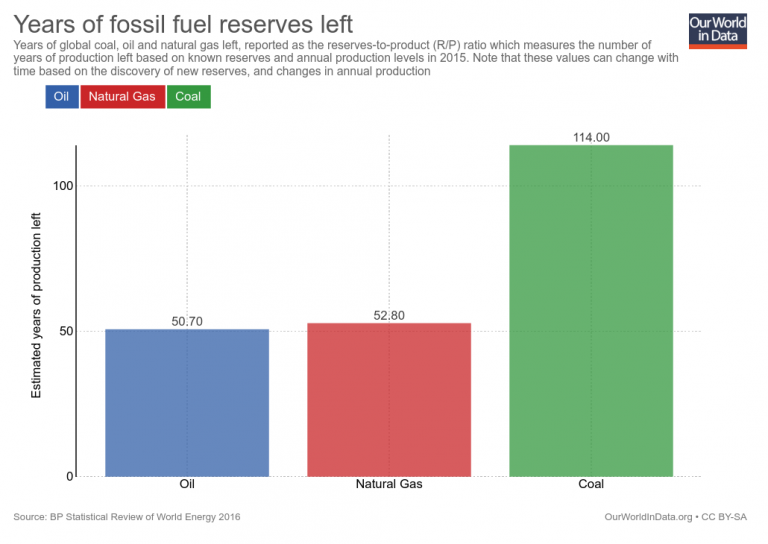
The Key to Renewable Energy
Rate of Consumption
Rate of use must be at or below rate of regeneration for renewables
Fossil fuels will run out because they take far longer to regenerate than the rate we use them
6.2 Global Energy Consumption
Developed vs Developing Countries
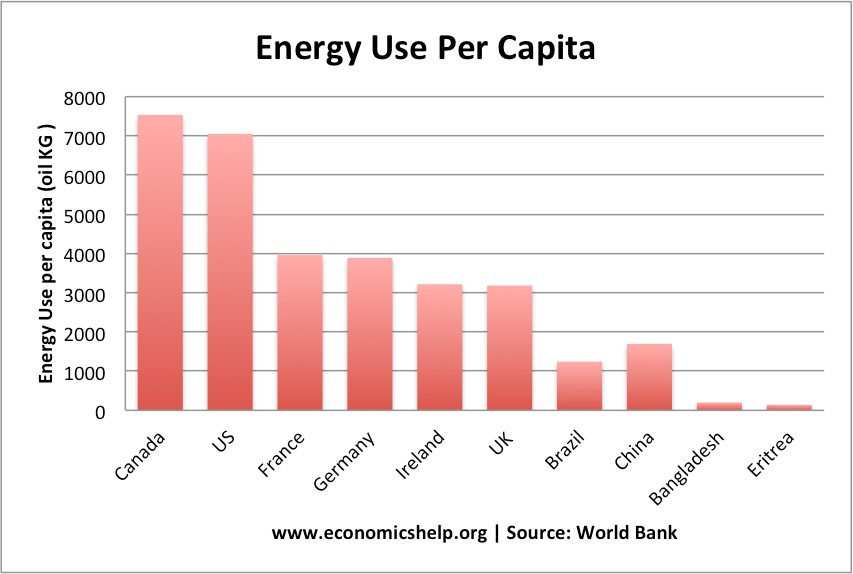
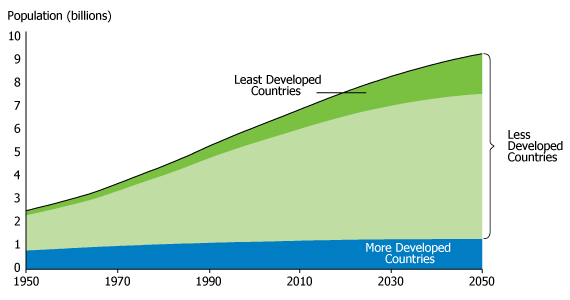
Developed nations use more energy on a per capita basis, but developing nations use more energy in total (higher pop.)
The average US resident uses 5x as much energy as the world average.
Developing nations are still industrializing & pop. is still growing rapidly
It will also increase on a per/person basis as their economies industrialize & residents achieve higher standards of living
Fossil Fuels: Most Used Energy Source
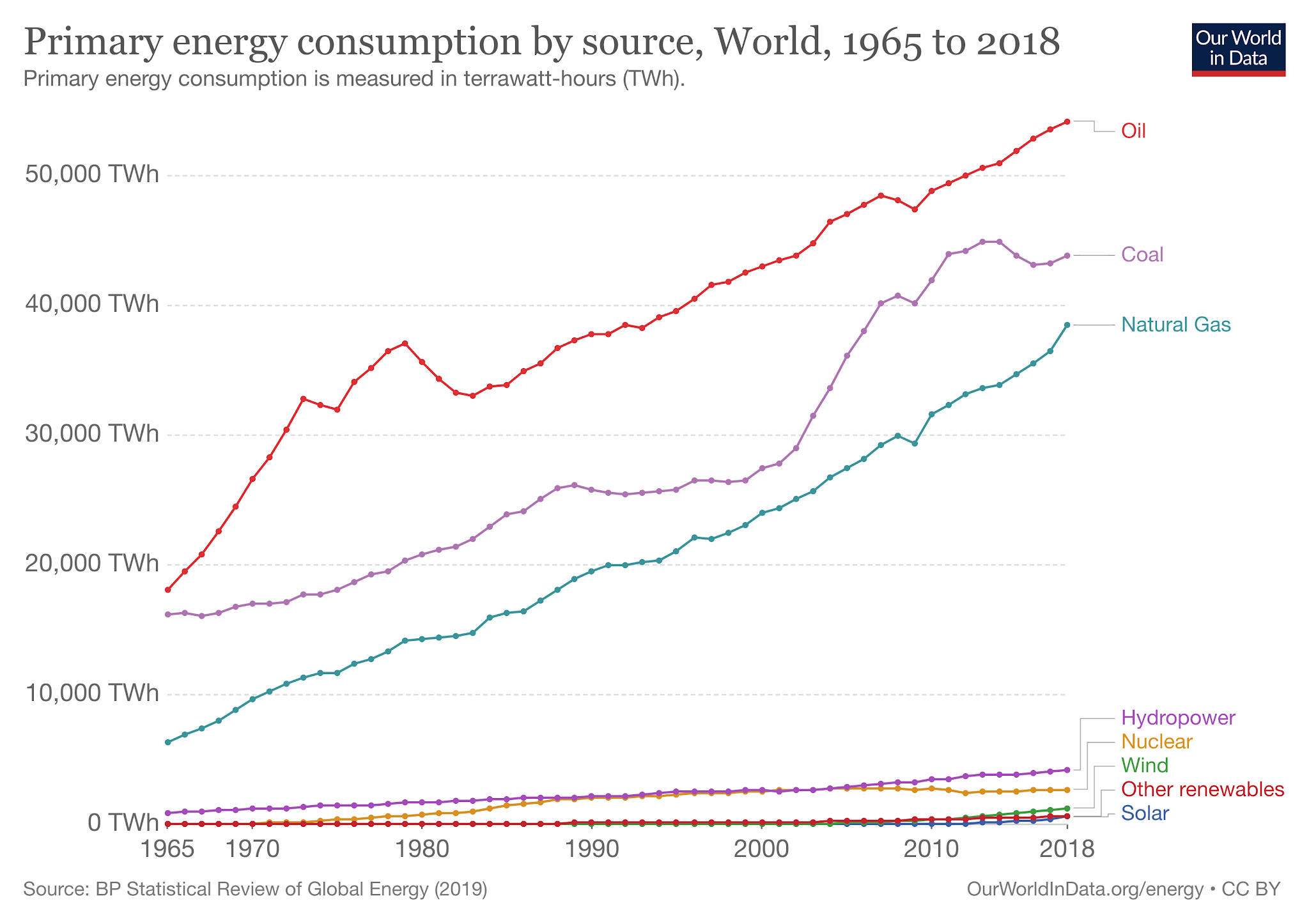
Fossil fuels are by far the most common fuel source globally
Oil ⇒ gasoline → main fuel for vehicles
Coal → main fuel for electricity generation
Natural gas is a secondary fuel for electricity generation & main fuel for heating
Hydroelectric energy (dams used to create electricity) is the second-largest source
Water spins a turbine which generates electricity
Nuclear is the third largest source
Uranium fission releases heat to turn water into steam to turn a turbine to gen. electricity
Development Increases FF Consumption
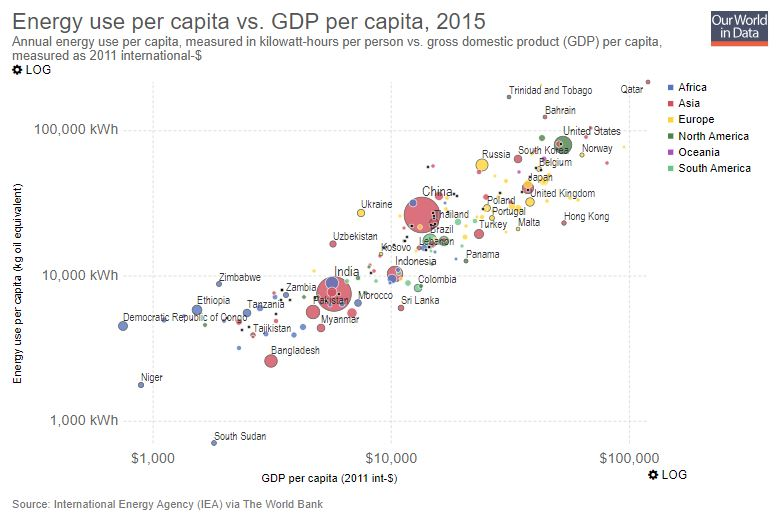
Many residents of less developed nations depend on subsistence fuels (biomass that they can easily gather/purchase)
Ex: wood, charcoal, dried animal manure
Can drive deforestation
Economical development → affluence (wealth) → higher per capita GDP → energy use
As developing nations develop, fossil fuel consumption will increase
Oil → Gasoline for vehicles
Coal & Natural gas → electricity
Electricity demand for homes & manufacturing
Factors That Affect Energy Source Use
Availability: fossil fuel use depends on discovered reserves and accessibility of these reserves
use of fossil fuels varies heavily with availability
Price: fossil fuel prices fluctuate dramatically with discovery of new reserves or depletion of existing ones
Fracking opens new NG reserves, increasing availability, decreasing price, increasing use
Government Regulation: the government can mandate certain energy source mixes (25% renewable by 2025)
Government CANNOT directly raise or lower prices of energy sources (ex: raise gas to $10/gallon)
Government CAN use
Taxes increases to discourage companies from building FF power plants
Rebates, or tax credits to encourage companies building renewable energy power plants.
6.3 - Fuel Types and Uses
Subsistence Fuels
Biomass fuel sources that are easily accessible (can be found and gathered by hand); often used in developing countries as a home heating or cooking fuel
Wood (and charcoal) are two of the most common fuel sources in developing nations
Wood is free/cheap to cut down and utilize as fuel; can cause deforestation & habitat loss
Charcoal is made by heating wood under low oxygen conditions for a long time
Peat is partially decomposed organic matter (often ferns or other plants) found in wet, acidic ecosystems like bogs and moors
Can be dried and used as a biomass fuel source
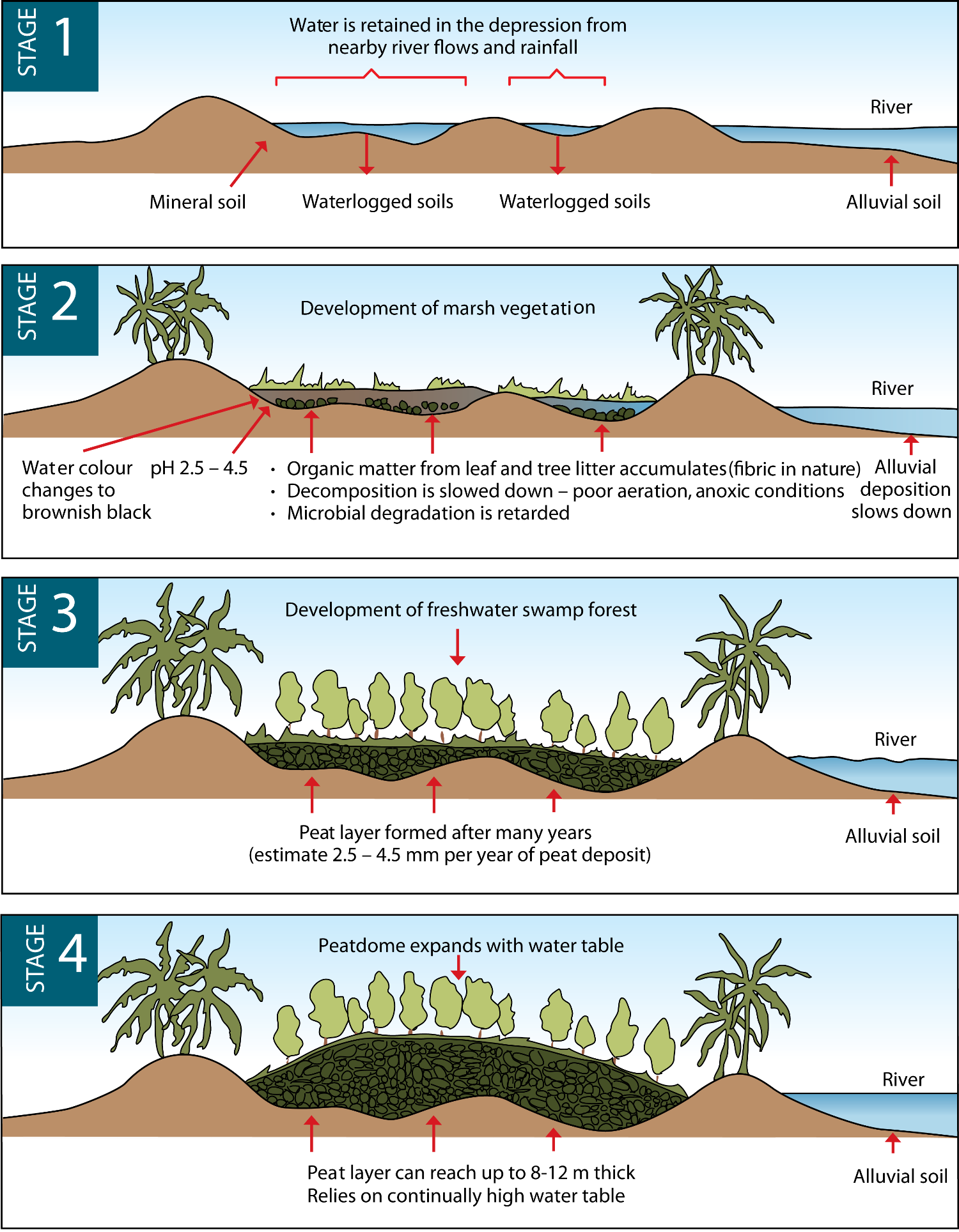
Coal Formation
Pressure from overlying rock & sediment layers compacts peat into coal over time
In order of energy density & quality: lignite → bituminous → anthracite
The deeper a coal reserve is buried, the more pressure from overlying rock layers & the more energy-dense
Because higher energy density means more energy released when a fuel source is burned, anthracite is the most valuable form of coal (highest quality)
Coal is burned to heat water into steam, to turn a turbine that generates electricity
More dense coal = hotter/longer fire = more steam = more electricity

Natural Gas
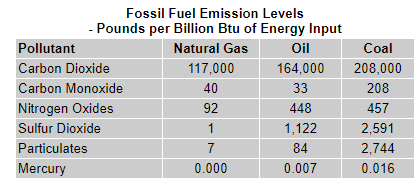
Decaying remains of plants & animals (mostly marine life) are buried under layers of rock & converted by pressure into oil (petroleum) and natural gas over time
Natural gas is mostly methane (CH4) and is found on top of trapped oil (petroleum) deposits
Forms when oil is trapped in a porous, sedimentary rock, underneath a harder, impermeable rock layer that doesn’t let the gas escape
Considered the “cleanest” fossil fuel (produces the fewest air pollutants & least CO2 when burned)
Produces about ½ as much CO2 as coal when burned to generate electricity
Produces virtually no PM (ash/soot)
Produces far less SOx, NOx than coal or oil, and NO MERCURY
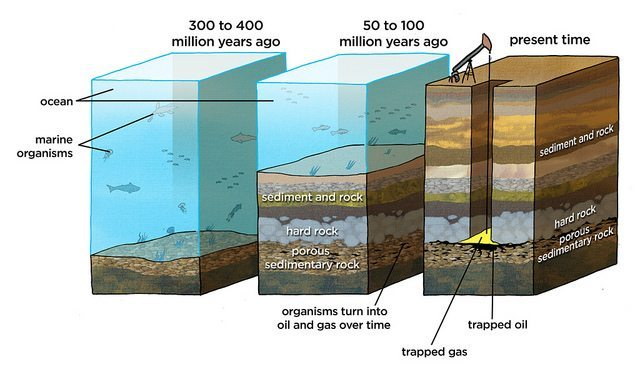
Crude Oil
Decaying organic matter trapped under rock layers is compressed into oil over time
Extracted by drilling a well through the overlying rock layers to reach the underground deposit and then pumping liquid oil out under pressure
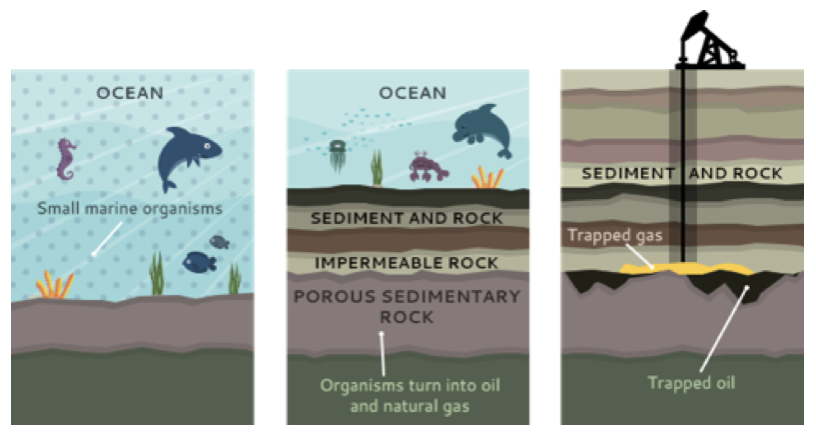
Fossil Fuel Products
Crude oil (petroleum) is converted into lots of different products through the process of fractional distillation
Crude oil is burned in a furnace and vapor passes into a column where different hydrocarbons are separated based on their boiling points
Hydrocarbons w/lower boiling points gather at the top of the column, higher boiling points gather at bottom
Different hydrocarbons within petroleum are used for different products
Petroleum gas
Gasoline (fuel for cars)
Naphtha (used to make plastic)
Jet fuel
Diesel fuel
Motor oil
Bitumen (asphalt for roads)
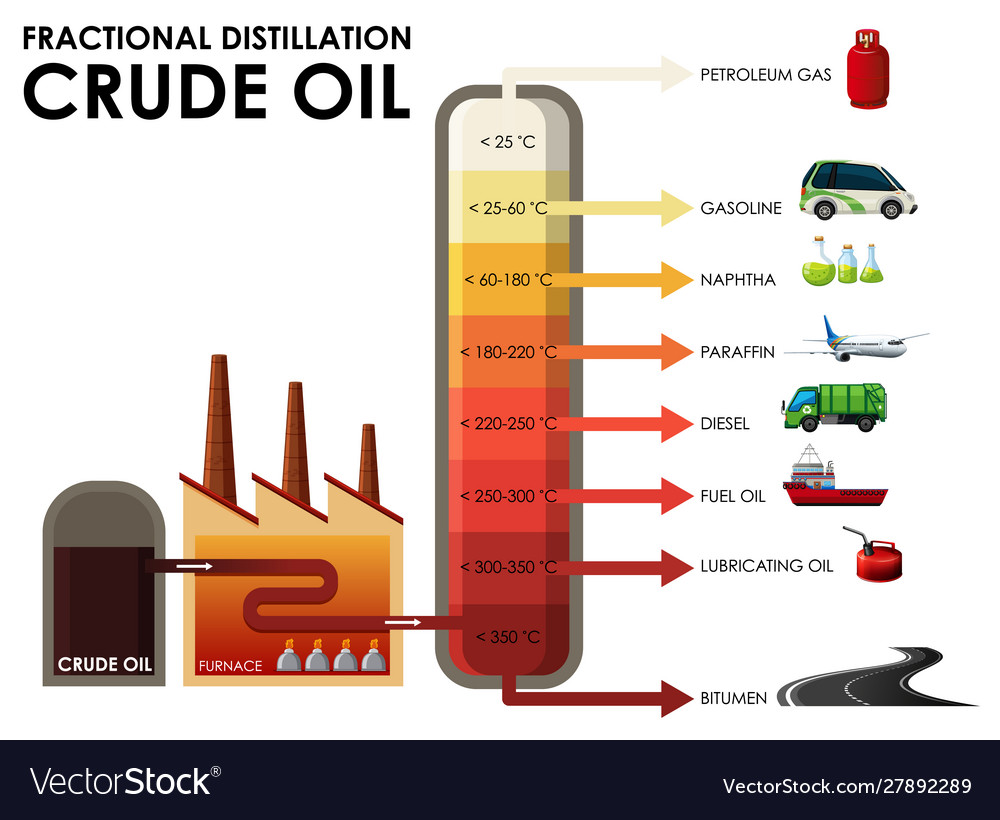
6.4 - Distribution of Natural Energy Resources
Coal
US
Russia
China
Australia
~100-150 years
Natural Gas
Russia
Iran
Qatar
US
Saudi Arabia
~50-60 years
Oil
Venezuela
Saudi Arabia
Iran
Canada
Iraq
~50 years
Fracking and Shale Gas

Hydraulic fracturing (aka fracking) is a method of natural gas extraction that has extended access to natural gas
Gas trapped in semi-permeable, sedimentary rock layers, such as shale, is released by cracking the rock with pressurized water
Fracking natural gas from shale rock increases & extends supply of natural gas
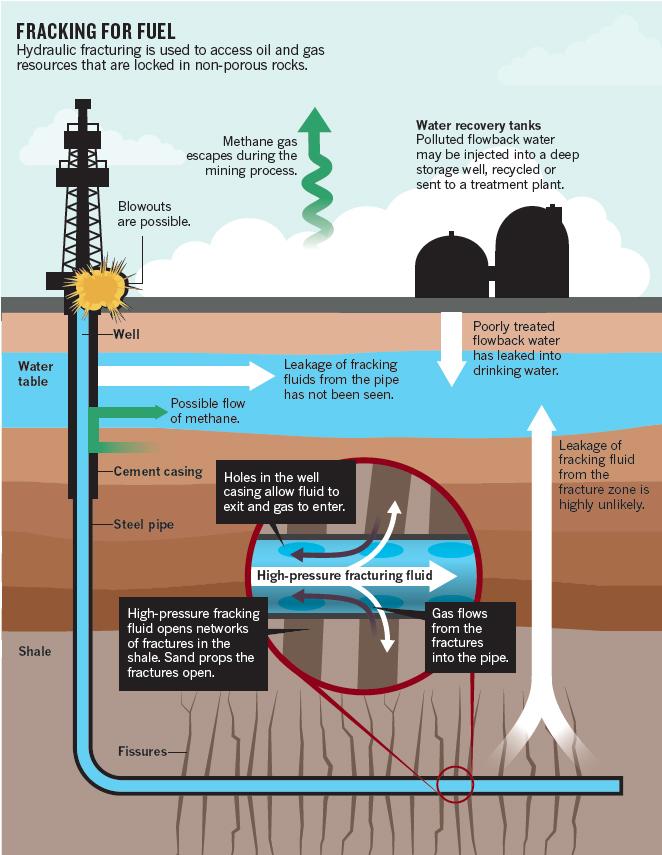
Shale Gas Reserves
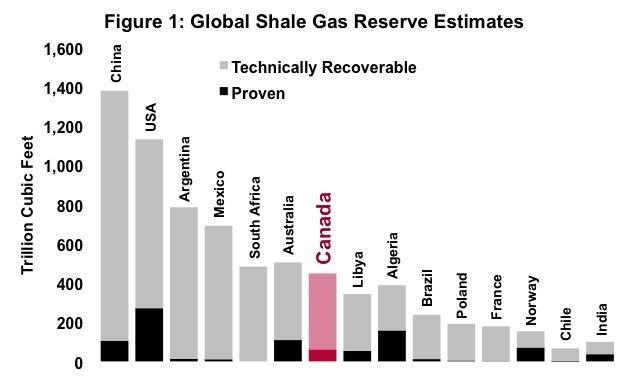
FFs are non-renewable, and will eventually be depleted, but short-term economic profit still drives extraction & use
Discovered, but unharvested reserves represent economic benefit to countries
Tar/Oil Sands
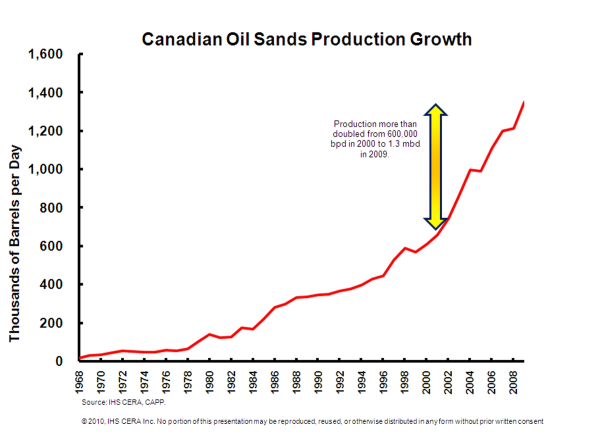
Tar or oil sands are bitumen deposits where crude oil can be recovered, but with higher water & energy inputs
Canada (Alberta region) = world’s largest oil sands reserve
Just like fracking, tar/oil sands extraction extends the world’s supply of crude oil
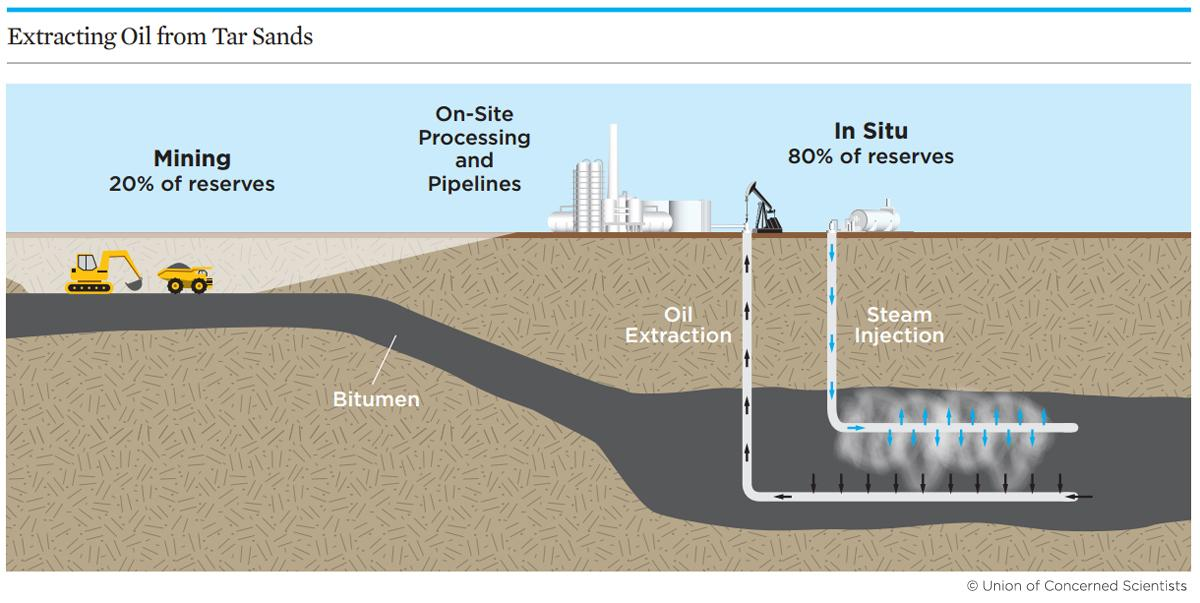
Crude Oil (Petroleum)
Decaying organic matter trapped under rock layers is compressed into oil over time
Extracted by drilling a well through the overlying rock layers to reach the underground deposit and then pumping liquid oil out under pressure
Can also be recovered from tar sands (combination of clay, sand, water, and bitumen)
Bitumen is a thick, sticky, semi-solid form of petroleum (not liquid)
Extracting & using oil from tar sands is extremely energy and water intensive
Lots of water needs to be heated (requiring energy) to create steam that’s piped down into the tar sand to melt the bitumen into a liquid that can flow up a pipe
Lots more water is used to separate the oil from all of the impurities (sand, clay) at the refinery

Fossil Fuel Products
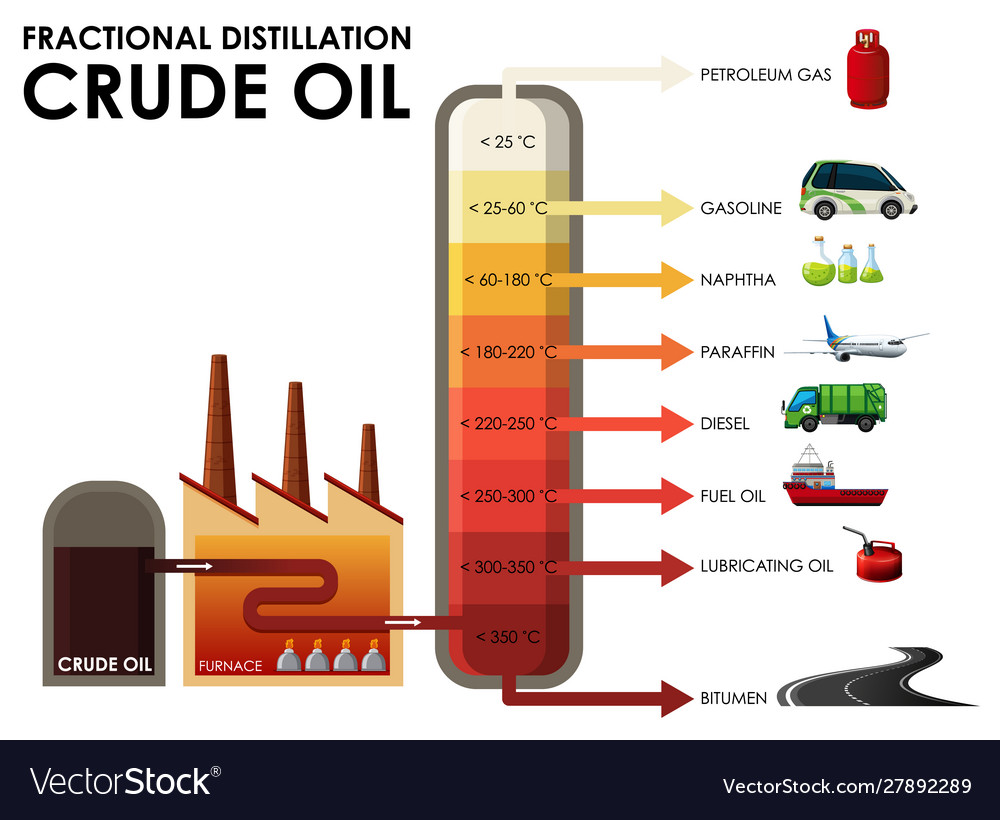
Crude oil (petroleum) is converted into lots of different products through the process of fractional distillation
Crude oil is burned in a furnace and vapor passes into a column where different hydrocarbons are separated based on their boiling points
Hydrocarbons w/lower boiling points gather at the top of the column, higher boiling points gather at bottom
Different hydrocarbons within petroleum are used for different products
Petroleum gas
Gasoline (fuel for cars)
Naphtha (used to make plastic)
Jet fuel
Diesel fuel
Motor oil
Bitumen (asphalt for roads)
6.5 - Fossil Fuels
Fossil Fuel Combustion
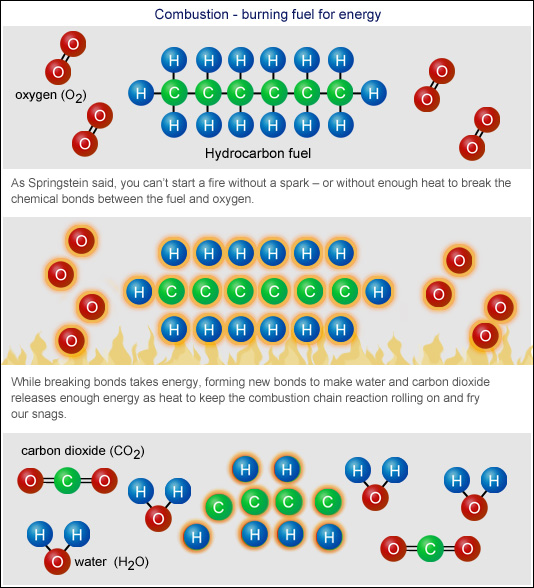
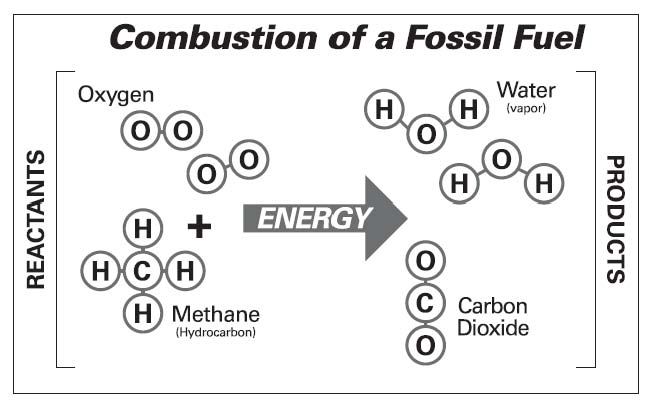
Reaction between Oxygen (O2) & fossil fuels (hydrocarbons) that releases energy as heat and produces CO2 & H2O as products
Remember: Combustion is a step in the CARBON cycle:
hydroCARBONS (FFs) are burned to release energy & the carbon
stored in them reacts with O2 in the air to form CO2Methane (natural gas), gasoline, propane, butane, coal are all fossil fuels (hydrocarbons) that release energy in the same way
Wood and biomass work the same, carbon is burned & reacts with O2 to form CO2 & give off energy
Fossil Fuels to Generate Electricity

The #1 source of electricity production globally is coal, followed by natural gas
These steps of electricity gen. are the same, no matter what you’re burning to produce the initial heat
Heat →Water into Steam → Steam turns a turbine → Turbine powers generator → Generator produces electricity
Coal, oil, natural gas, biomass, and trash can all be burned to drive this same process and create energy.
Even nuclear energy works similarly, with nuclear fission producing the initial heat
Environmental Consequences: Coal
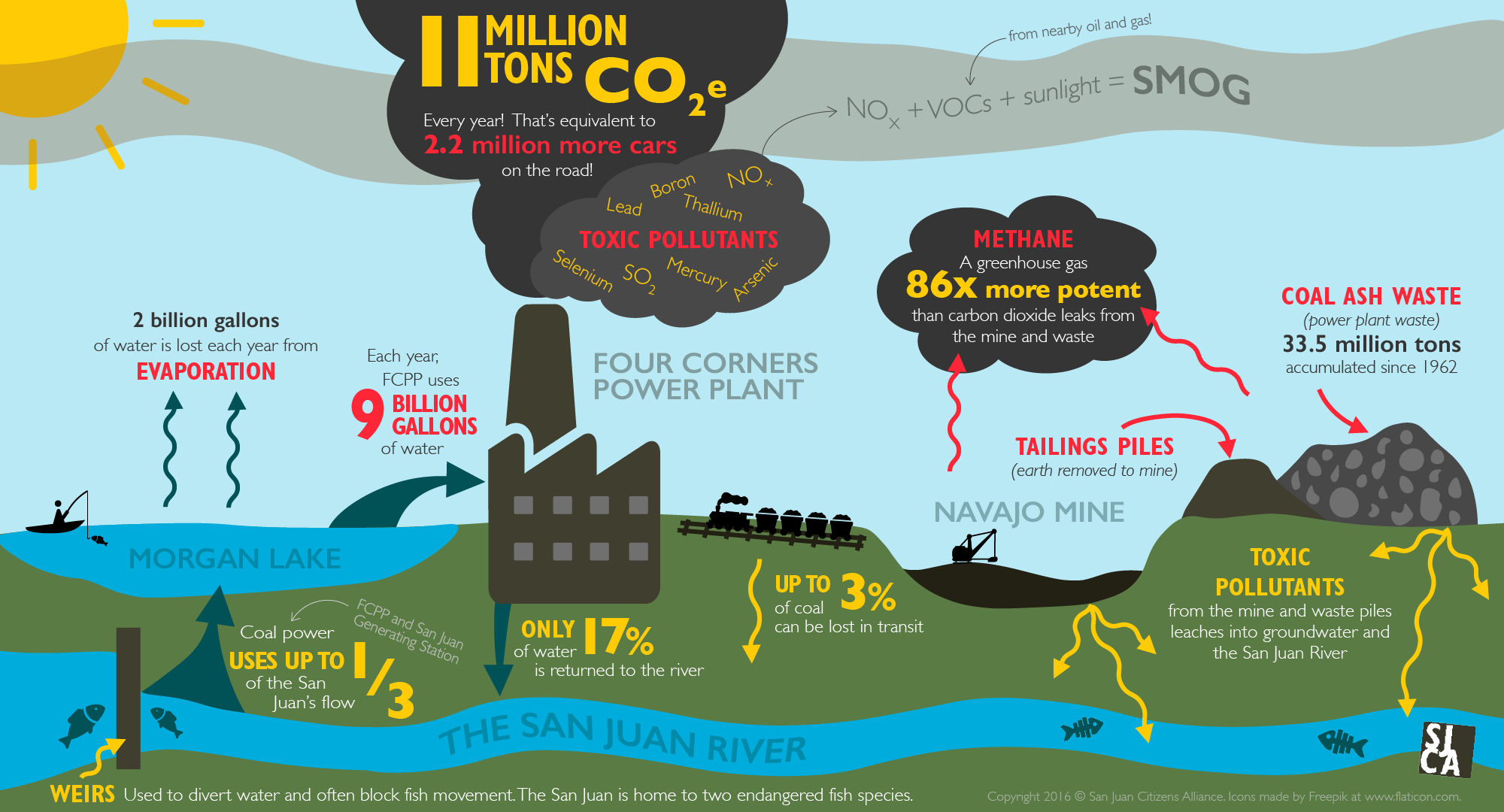
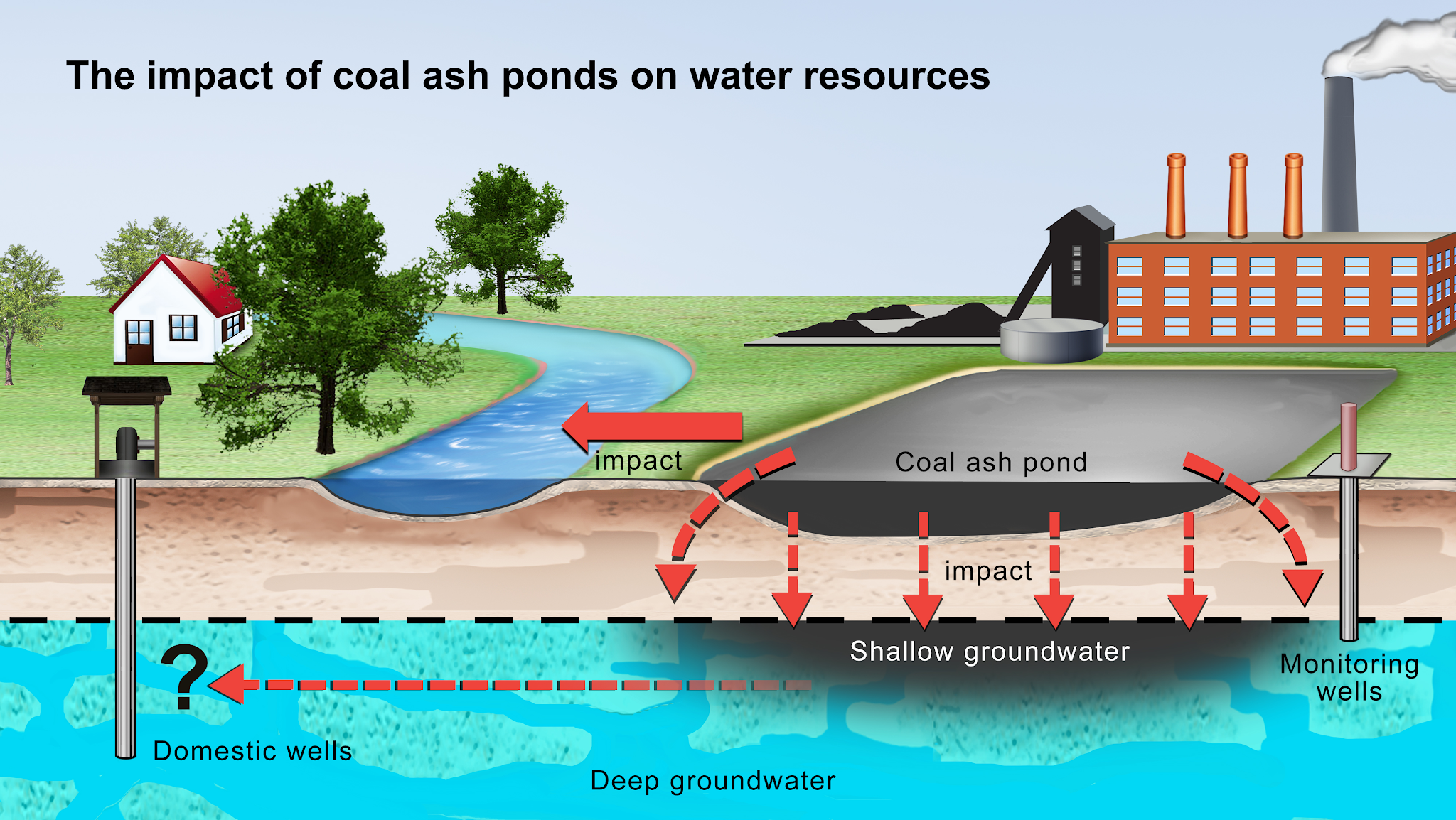
Habitat destruction to clear land for mining
Produces pollutants & releases CO2 (GHG → global warming)
Releases more CO2 than any other FF when burned for electricity gen.
Releases PM (soot, ash) which can irritate respiratory tracts of humans/animals
Produces toxic ash contaminated with lead, mercury, and arsenic
Taken to landfills or stored in ash ponds; both can leak into ground/surface waters, or into soil
Releases SOx & NOx (sulfur and nitrogen oxides) which irritate resp. systems, and contribute to smog and acid precipitation
Generating Electricity
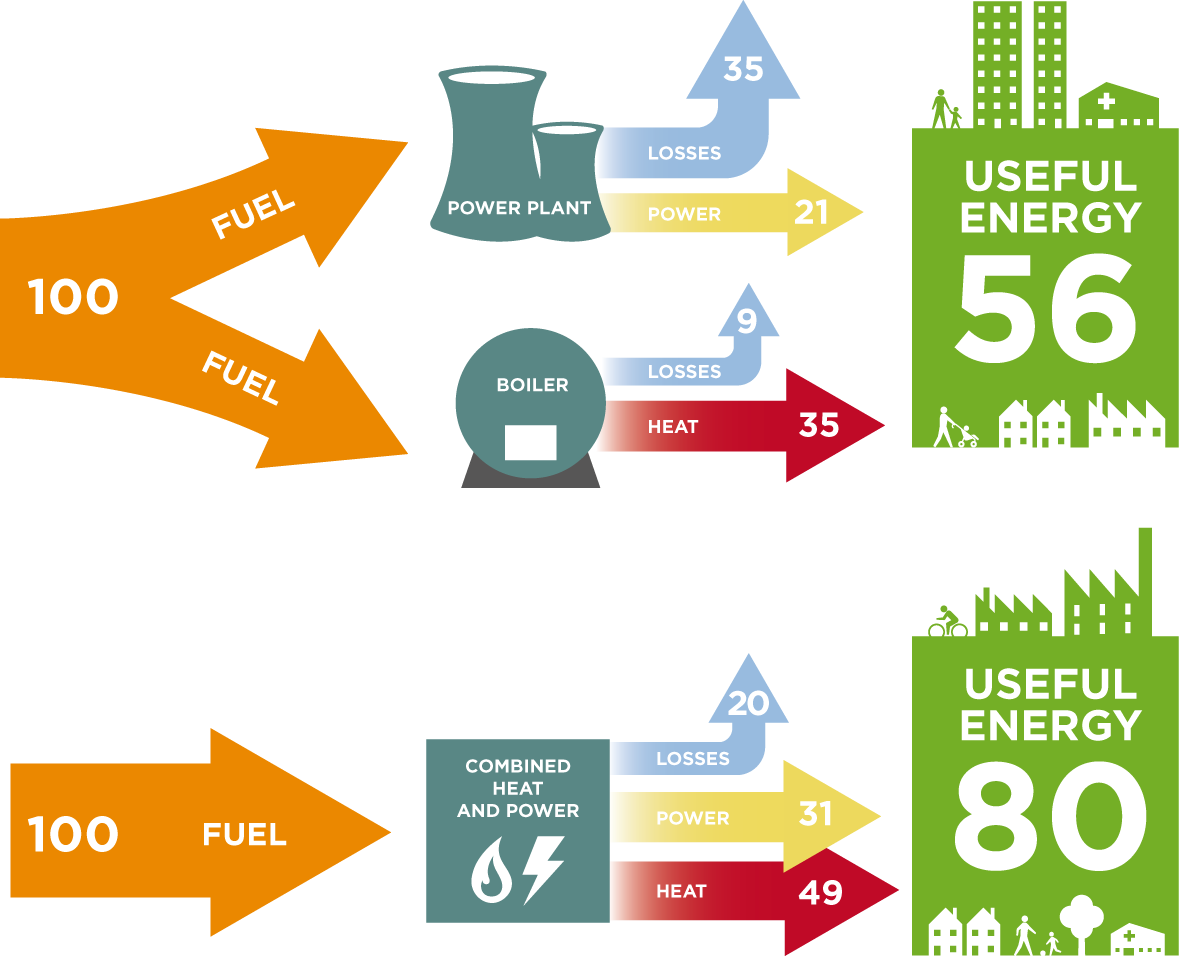
Coal is ~30% efficient as a fuel source for generating electricity (30% of energy from the bonds in the hydrocarbons are converted to electricity)
Nat. Gas is ~60% efficient when it’s burned to generate electricity
Much of the energy “lost” or not converted into electricity escapes as heat
Cogeneration: when the heat produced from electricity generation is used to provide heat (air & hot water) to a building;
CHP (Combined Heat and Power) systems are close to 90% efficient (much better than coal/NG alone)
Oil/Petroleum Extraction
Extracted by drilling a well through the overlying rock layers to reach the underground deposit and then pumping liquid oil out under pressure
Can also be recovered from tar sands (combination of clay, sand, water, and bitumen)
Environmental Consequences: Tar Sands
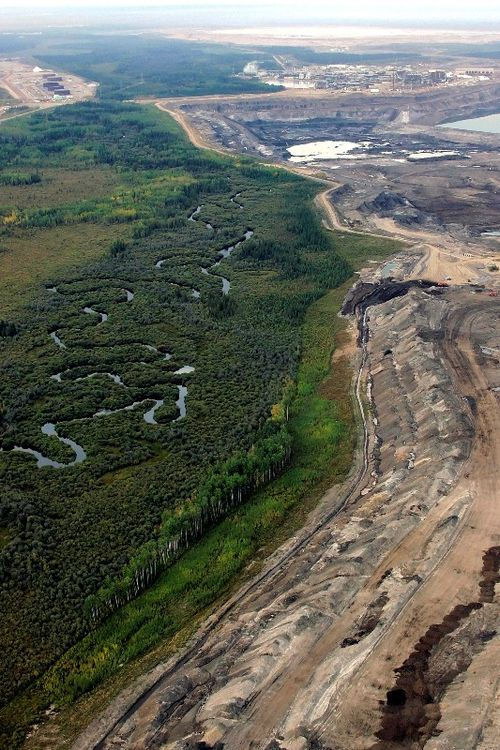
Habitat destruction to clear land for: roads, drilling equipment, digging through ground surface to reach deposits (biodiv. loss)
Ground or nearby surface water depletion (H2O needed for steam & for washing impurities from bitumen at refinery)
Water contamination: tailing ponds (holes dug for storing wastewater) can overflow & run into nearby surface waters, or leach into groundwater
Benzene (carcinogen) salts, acids, hydrocarbons, bitumen
All toxic to plant and animals
CO2 released by machinery during extraction, transport, refinement
Environmental Consequences: Crude Oil/Petroleum
Possibility of spill (either from tanker ships or pipelines breaking
Spills in water = crude oil covering sun, clogging fish gills, suffocating many ocean animals, sticking to bird feathers
Spills on land = toxic to plant roots, surface or groundwater contamination (with hydrocarbons/crude oil)
Habitat loss or fragmentation when land is cleared for roads, drilling equipment, pipelines
Fracking (Hydraulic Fracturing)
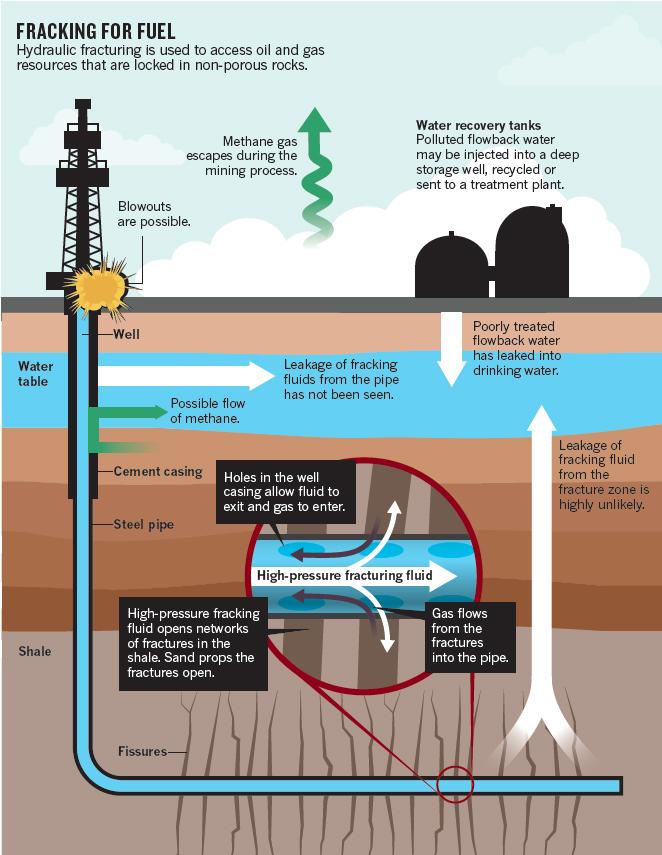
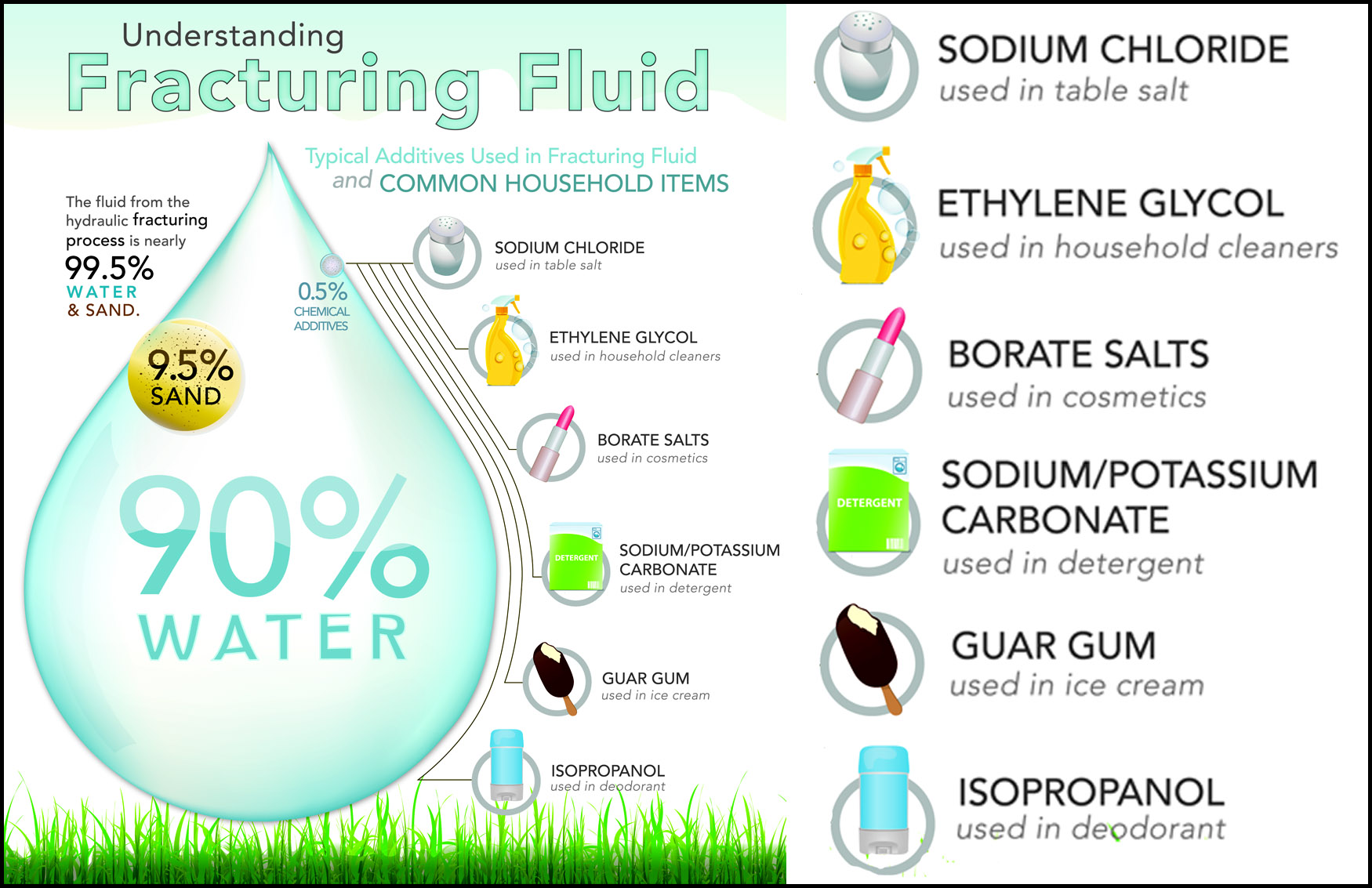
Used to extract natural gas from sedimentary rock
Vertical well is drilled down to sed. rock layer, then turns horizontally into the rock layer
Perforating gun cracks (fractures) the rock layer around hor. well, making it more permeable
Fracking fluid (water, salt, detergents, acids) is pumped into well @ very high pressure to crack the rock even more & allow natural gas to flow out
Nat. gas is collected @ surface & shipped for processing/use
Flowback water (used fracking fluid) flows back out well & is collected and stored in containers or ponds nearby
Environmental Consequences: Fracking
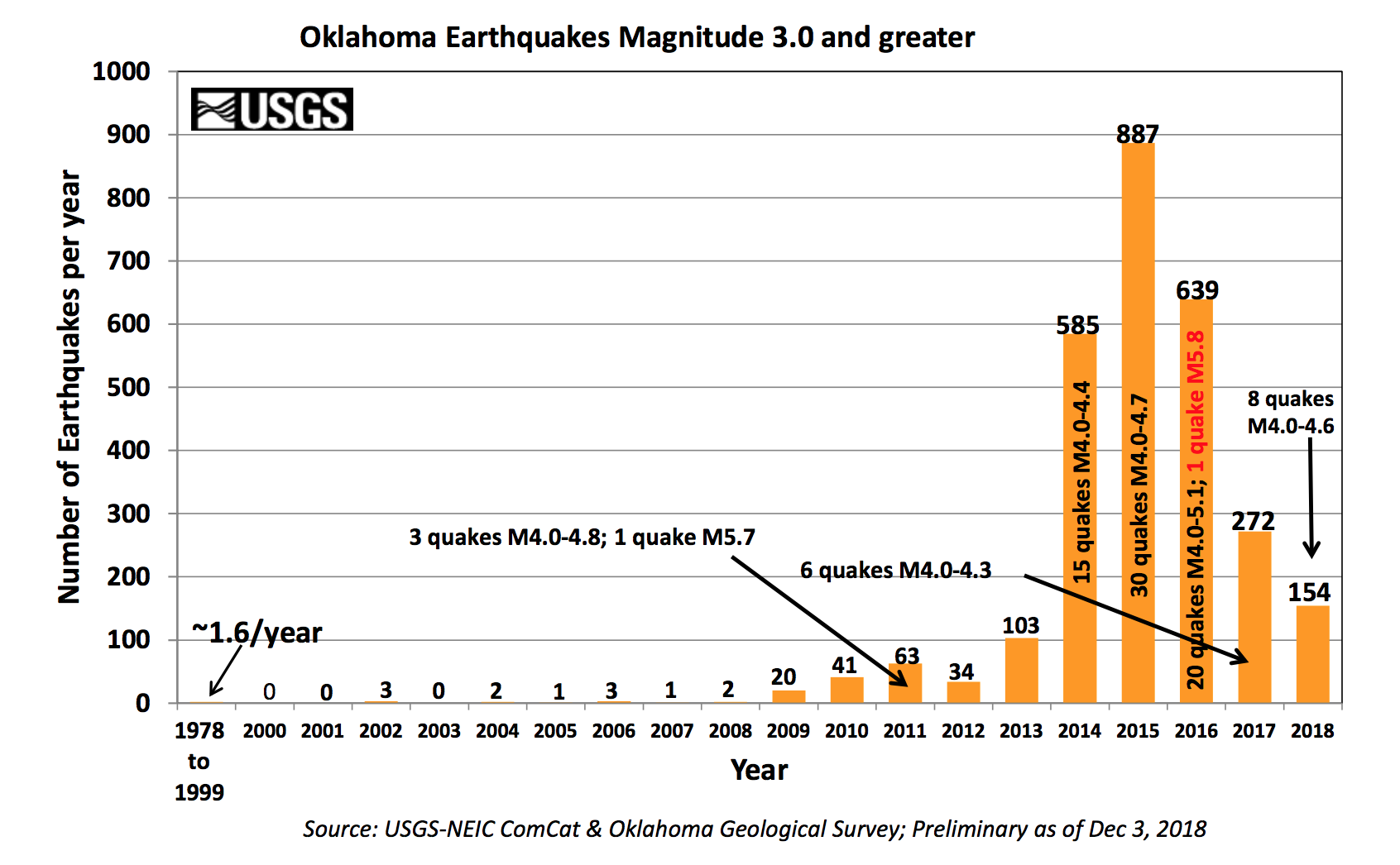
Possibility of well leaking & contaminating groundwater with fracking fluid (salt, detergents, acids) or hydrocarbons
Ponds can overflow or leach into ground & contaminate surface or ground waters with fracking fluid (salt, detergents, acids)
Can be toxic to plants & animals that rely on these water sources
Depletion of ground or surface waters nearby (as they’re drawn from for fracking fluid)
Increased seismic activity (earthquakes) linked with wastewater injection wells (storing fracking fluid deep underground)
Hab. loss/fragment
CH4 (GHG) release
6.6 - Nuclear Energy
Nuclear Fission and Radioactivity

A neutron is fired into the nucleus of a radioactive (unstable) element, such as Uranium
Nucleus breaks apart and releases lots of energy (heat) + more neutrons that break more nuclei apart, releasing more energy (chain reaction)
Radioactivity refers to the energy given off by the nucleus of a radioactive isotope (Uranium-235)
Radioactive nuclei decay, or breakdown and give off energy (radiation) even without fission; nuclear fission just releases tons of energy all at once
Radioactive Half-Life: the amount of time it takes for 50% of a radioactive substance to decay (breakdown)
Ex: ½ life of Cobalt-60 isotope = 5.27 yrs.
In 5.27 yrs, ½ of a Co-60 sample would be gone (decayed)
Generating Electricity
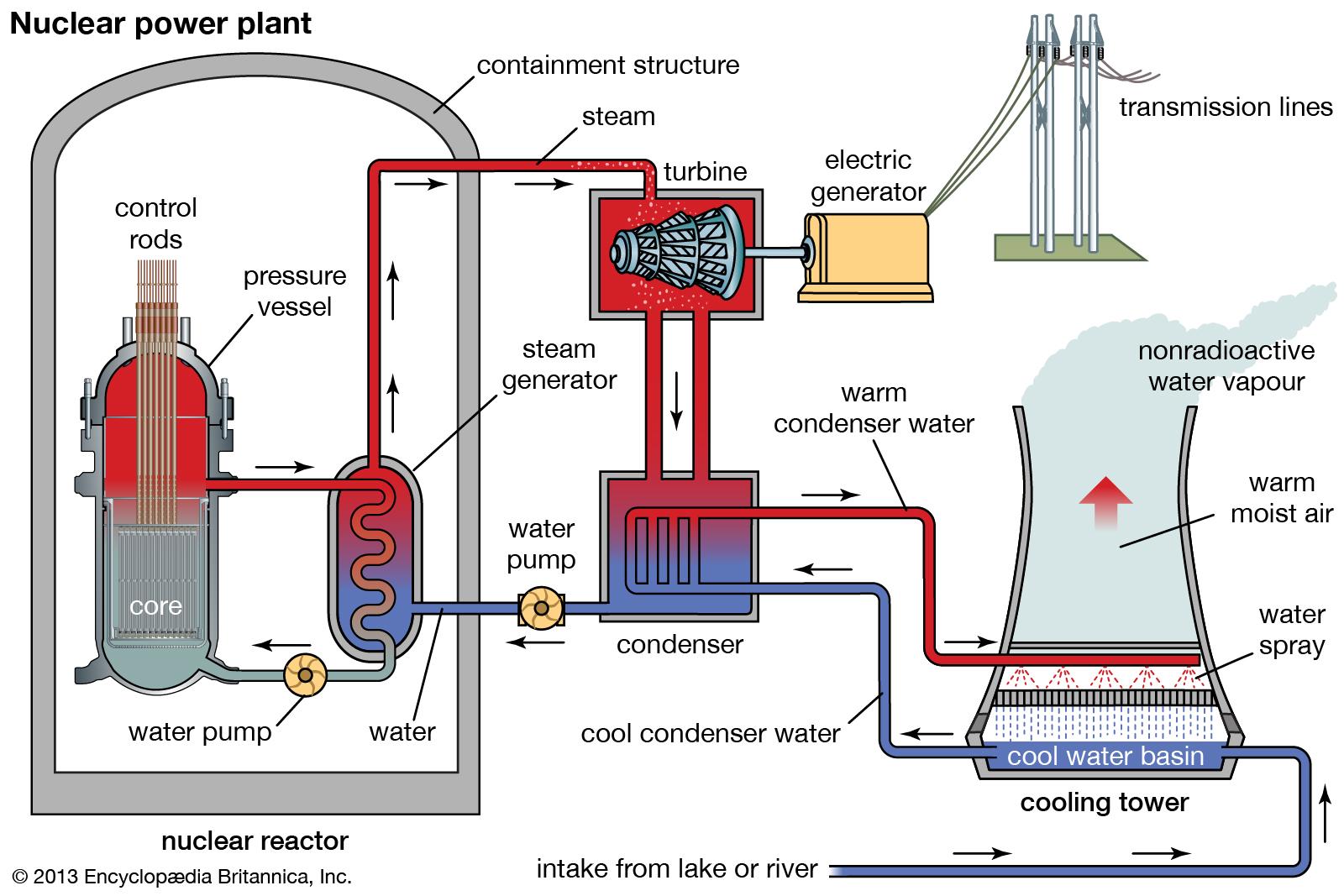
Same electricity generation process as with FFs, just uranium fission to heat water into steam
Heat →Water into Steam → Steam turns a turbine → Turbine powers generator → Generator produces electricity.
U-235 (Uranium) stored in fuel rods, submerged in water in reaction core; heat from fission turns H2O → steam...
Control rods are lowered into reactor core to absorb neutrons and slow down the reaction, preventing meltdown (explosion)
Water pump brings in cool water to be turned into steam and also cools reactor down from overheating
Cooling tower allows steam from turbine to condense back into liquid and cool down before being reused (this gives off H2O vapor)
Nonrenewable, but cleaner than Fossil Fuels!
⛰ Nuclear energy is NONRENEWABLE because radioactive elements like Uranium are limited
No air pollutants (PM, SOx/NOx) or CO2/CH4 released when electricity is generated; mining of uranium & plant construction still release GHGs
Only gas released from elec. gen. is water vapor (which is technically a GHG, but stays in atm, very briefly)
⛰ Other drawbacks of nuclear energy include possibility of meltdown & radioactive contamination
Spent Fuel Rods: used fuel rods remain radioactive for millions of years & need to be stored in lead containers on site @ Nuclear PPs
Mine tailings: leftover rock & soil from mining may have radioactive elements that can contaminate water or soil nearby
Water use: nuclear PPs require lots of water and can deplete local surface or groundwater sources
Thermal Pollution: hot water from PP released back into surface waters can cause thermal shock (decreased O2 & suffocation)
Nuclear Meltdowns
Three Mile Island (US), Fukushima Japan, and Chernobyl Ukraine = 3 most famous nuclear meltdowns
Three Mile Island (US): partial meltdown due to testing error; radiation released but no deaths or residual cancer case
Fukushima (Japan): an earthquake and tsunami triggered cooling pump failure that lead to a meltdown (explosion of reactor core) & widespread radiation release
Chernobyl (Ukraine): stuck cooling valve during test lead to complete meltdown (explosion of reactor core), several deaths, and widespread radiation release
Environmental consequences of meltdowns: genetic mutations & cancer in surrounding people, animals, and plants due to radiation released from reactor core
Contaminated soil: radiation can remain in soil and harm plants and animals in the future (genetic mutations)
Radiation spread: radiation can be carried by the wind over long distances, affecting ecosystems far from the meltdown site
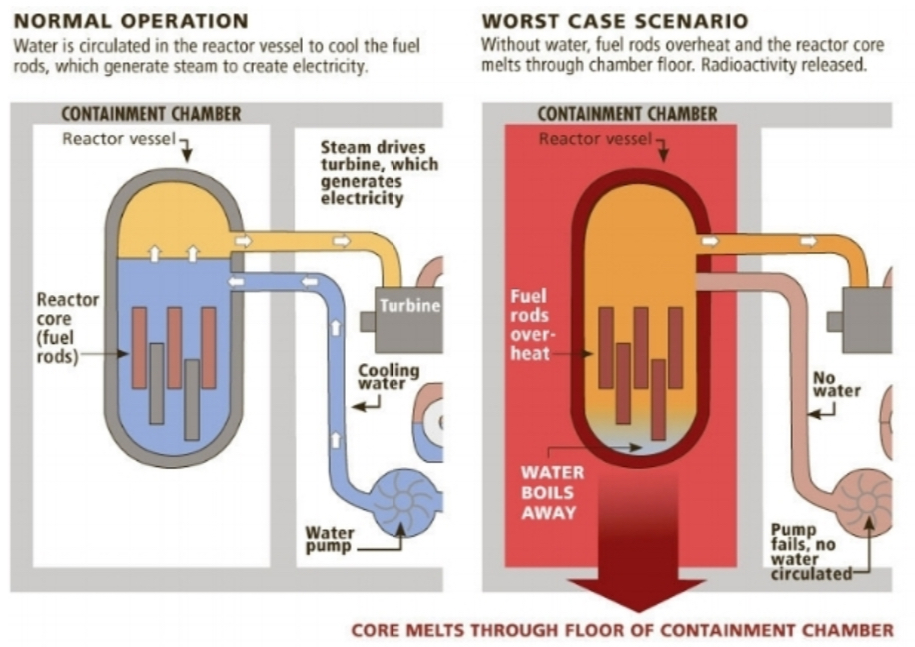
6.7 - Energy From Biomass
Biomass VS. Biofuels
Biomass: organic matter (wood/charcoal, dried animal waste, dead leaves/brush) burned to release heat - primarily for heating homes/cooking
Utilized primarily in developing world for heating homes & cooking food
Easy to harvest, available, cheap/free (subsistence fuel)
Can also be burned in PPs to generate electricity (less common than FFs)
Biofuels: liquid fuels (ethanol, biodiesel) created from biomass (corn, sugar cane, palm oil)
Used as replacement fuel sources for gasoline, primarily in vehicles
Modern VS. Fossil Carbon

Biomass burning releases CO2, but doesn’t increase atmospheric CO2 levels like FF burning does
Burning biomass releases modern carbon (CO2 that was recently sequestered, or taken out of the atmosphere) whereas FF burning releases fossil carbon that had been stored for millions of years
Biomass burning is considered “carbon neutral”
Think of spending a dollar someone just gave you vs. withdrawing from your long-term savings account to spend
Human Health and Environmental Consequences of Biomass Burning
Biomass burning releases CO, NOx, PM, and VOCs - all respiratory irritants
3 billion people globally cook on open, biomass fires, mostly in developing world
Biomass burn. indoors for heat/cooking worsens effects (pollutants trapped & conc.)
Worsened asthma, bronchitis, COPD, emphysema, eye irritation
Environmental consequences = deforestation & air pollutants
Lack of environmental protection laws & financial resources for other fuels lead to more biomass deforestation in developing nations
Hab. loss, soil erosion, loss of CO2 sequestration, air & H2O filtration
NOx, VOCs, and PM all contribute to smog formation
Biofuels: Ethanol and Algae
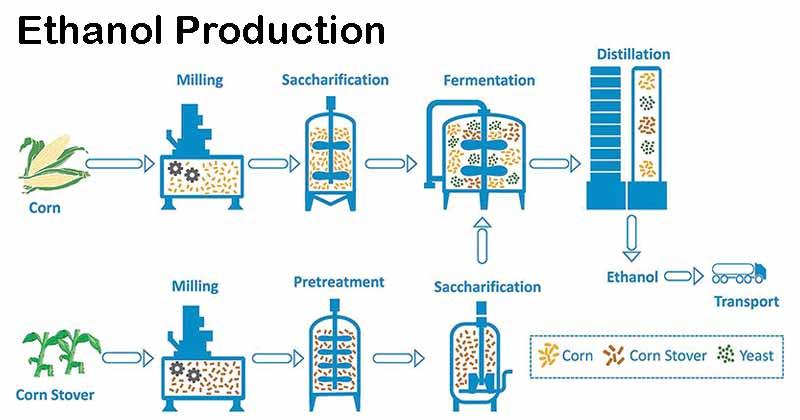
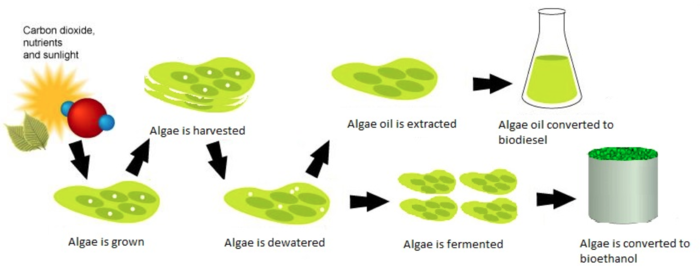
Corn & sugar cane are fermented into ethanol which is mixed w/ gasoline
Corn grain/sugar cane broken down & yeast ferment sugars → ethanol
E85 or flex fuel = 51-83% ethanol + gasoline mix; used in flex-fuel vehicles
Decreases oil consumption for transport, but is less efficient than pure gasoline
“renewable” only to the extent that the production of corn is sustainable (sugar cane is a perennial, and is more sustainable)
Environmental consequences = all the neg. consequences of monocrop ag.
Soil erosion, hab. loss, GHG release (ag. soils, tractors, fertilizers) H2O use
Lots of corn needed, relative to petroleum; can compete w/human cons. of corn
Algae produce oils that can be used as biofuels more sustainably than corn
Biodiesel
Liquid fuels produced specifically from plant oils (soy, canola, palm)
Palm oil biodiesel has been found to produce 98% MORE GHGs than FFs, due to clearing of forest for palm plantations
Can be more sustainable if already cleared land is used, or if plantations are continually replanted (however, also causes all the env. impacts of ag.)
6.8 - Solar Energy
Active VS. Passive Solar Energy
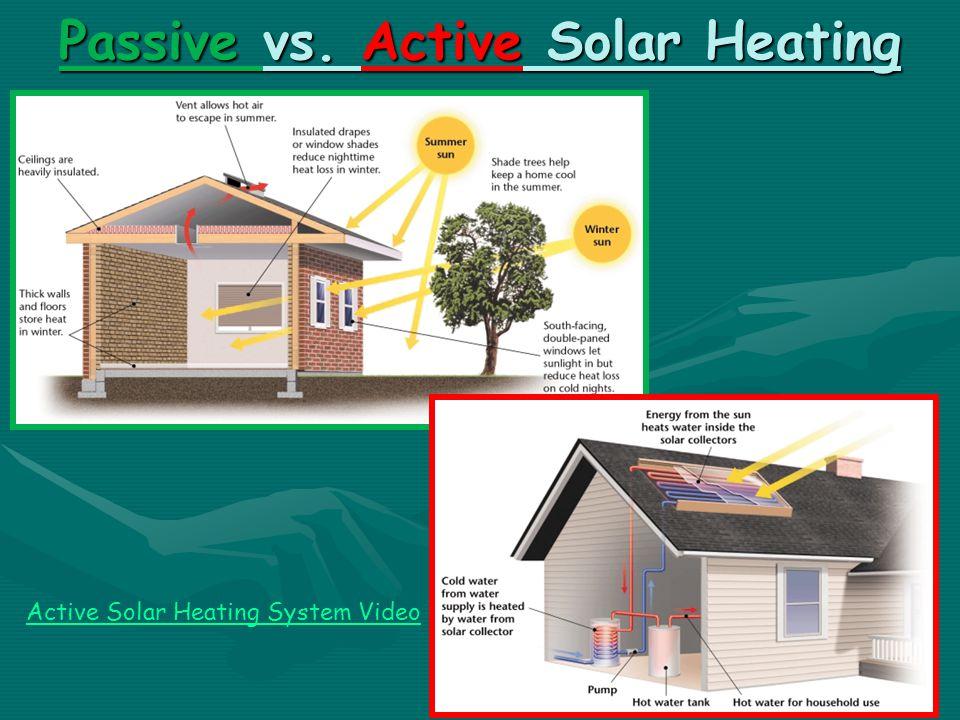
Passive solar: absorbing or blocking heat from the sun, w/out use of mechanical/electrical equip.
Using sun’s heat to cook food in a solar oven
Orienting building design to block sunlight in warmer months & allow sunlight in during colder months
Double paned windows, southern facing windows w/roof overhang, deciduous shade trees, skylight to decrease elect. use, dark colored sunlight abs. floor
Active solar: use of mechanical/electrical equip. to capture sun’s heat (solar water heaters or CST - concentrated solar thermal), or convert light rays directly into electricity (PV cells)
Solar water heaters capture sun’s heat in water or circulating fluid & transfer heat to warm water for home - in place of electric/gas water heater
Photovoltaic Cells (PV)
Aka “solar panels”; contain semiconductor (usually silicon) that emits low voltage electrical current when exposed to sun
Photons (particles carrying energy from sun) cause separation of charges between two semiconductor layers (n & p); electrons separate from protons & flow through circuit to load, delivering energy (as electricity)
PV cells on a roof can directly power the building, or send excess electricity back to the grid for other users (earning you a credit from your utility company)
A drawback is intermittency (solar energy can only be generated during the day)
Could be solved by cheaper, larger batteries that can store energy generated during the day for use at night
Currently these aren’t cost-effective yet
Concentrated Solar Thermal (CST)
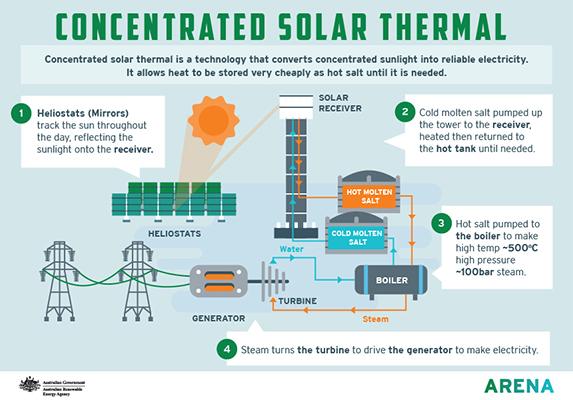
Heliostats (mirrors) reflect sun’s rays onto a central water tower in order to heat water to produce steam to turn a turbine → electricity
A drawback is habitat destruction & light beams frying birds in mid air
Community (solar farm) VS. Rooftop Solar
FRQ tip: don’t just say “solar panels” differentiate between rooftop (individual home/business) solar and community or large-scale solar farms
Large-scale solar “farms” can generate lots of electricity, but do take up land and cause habitat loss/fragmentation
Rooftop solar doesn’t take up land, but only produces a little electricity
Solar Energy Pros and Cons
Pros
No air pollutants (PM, SOx, NOx) released to gen. electricity
No CO2 released when generating electricity
Renewable, unlike FFs which will run out
No mining of fossil fuels for electricity Production
Cons
Semiconductor metals (silicon) still need to be mined to produce PV cells (solar panels)
This can disrupt habitats and pollute water with mine tailings, air with PM
Silicon is a limited resource
Solar panel farms can displace habitats
6.9 Hydroelectricity
Hydroelectricity Basics
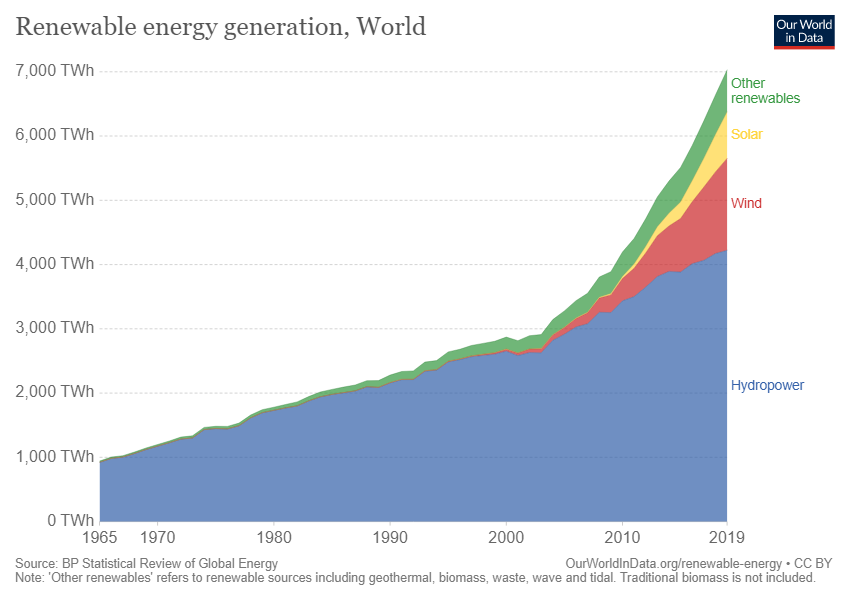
Kinetic energy of moving water → spins a turbine (mechanical energy) → turbine powers generator
Water moves either with natural current of river or tides, or by falling vertically through channel in a dam
By far the largest renewable source of electricity globally
China, Brazil, and US = 3 biggest hydroelectricity producers
Water Impoundment (DAMS)

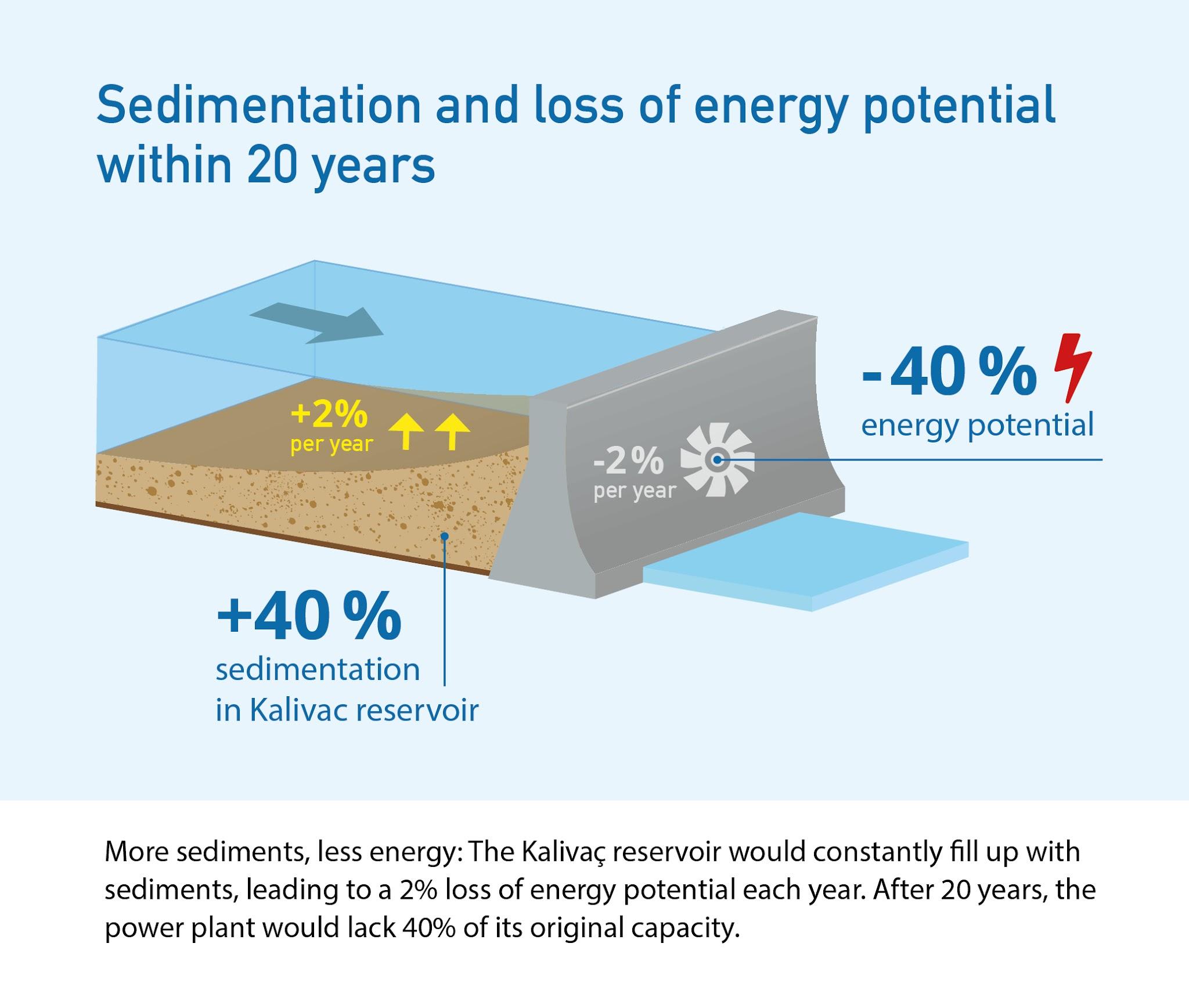
Dam built in a river creates a large artificial lake behind the dam (reservoir)
Damming the river enables operators to allow more or less water through the channel in the dam, increasing or decreasing electricity production (water flows through channel, turns turbine, turbine powers generator → ⚡)
Also allows for control of flow downstream, prevention of seasonal flooding due to high rainfall
Reservoirs are also a source of recreation money (boating fees, tourism, increased property values, fishing, etc.)
2 big impacts = flooding of ecosystems behind dam & sedimentation (buildup of sediments behind dam)
Run of River System and Tidal Energy

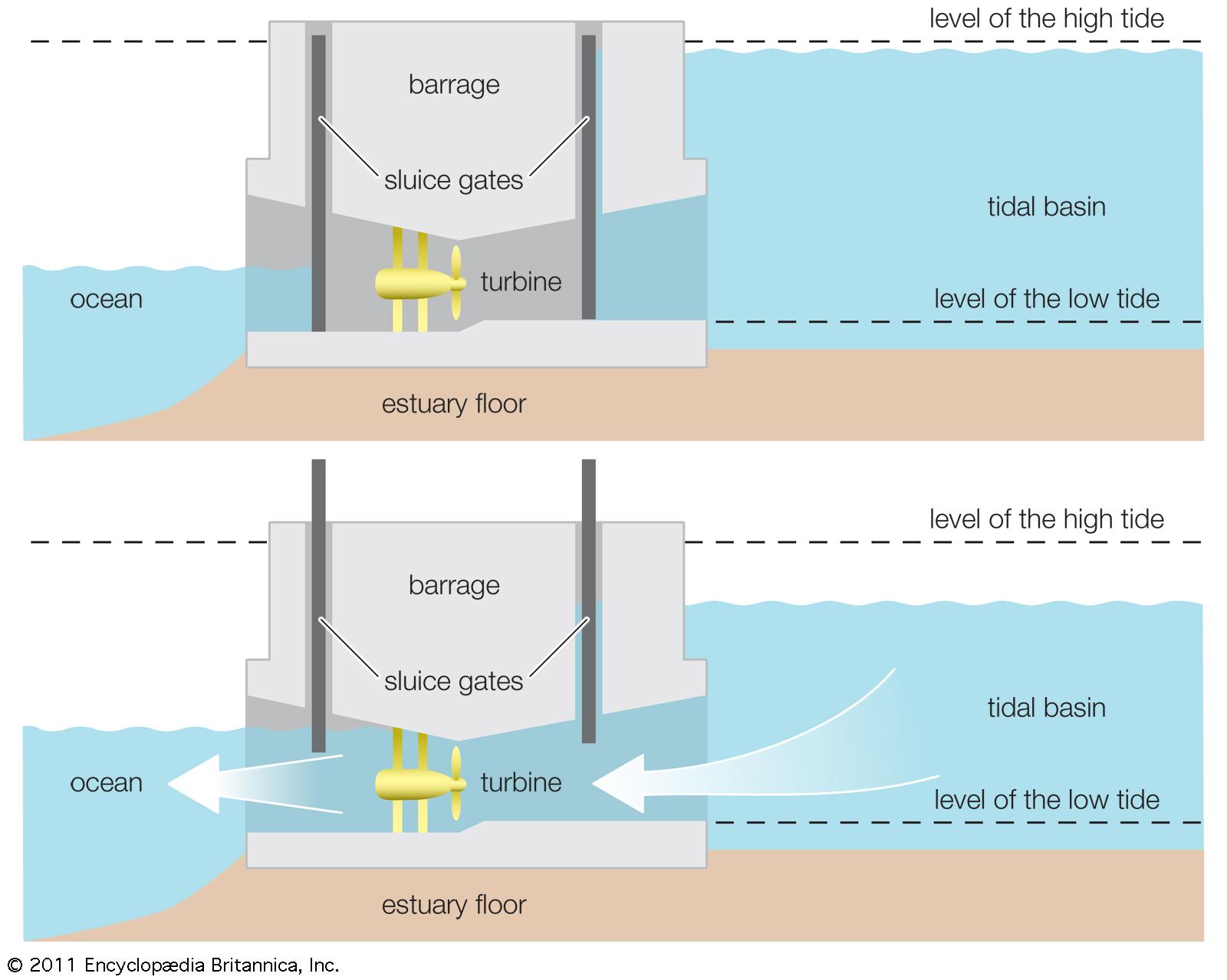
A dam diverts the natural current of a river through man-made channel beside the river
Natural current of the river turns the turbine...powers the generator...⚡
Less impactful to surrounding ecosystem since no reservoir is formed & ecosystems behind dam aren’t flooded
Doesn’t stop natural flow of sediments downstream like water impoundment systems do
Doesn’t generate nearly as much power & may be unavailable in warmer seasons when river water levels are lower
Tidal power comes from tidal ocean flow turning turbine (coastal areas only
Drawbacks of Hydroelectric Dams
Ecological:
Reservoir floods habitats behind dam (forst/wetlands are gone; river becomes a lake)
Prevents upstream migration of fish like salmon, that need to swim up to spawning grounds to reproduce
Sedimentation changes upstream and downstream conditions
upstream becomes warmer (less oxygen) and rocly streambed habitats covered in sediment
downstream loses sediment (important nutrient source), decreased water level, loses streambed habitat
downstream wetlands especially suffer since nutrients in sediment don’t reach them
Environmental:
fossil fuel combustion during dam construction, increased evaporation due to the larger surface area of the reservoir, and methane release due to the anaerobic decomposition of organic matter in reservoir
Economic:
human homes and businesses must be relocated due to reservoir flooding, initial construction is very expensive (does create long-term jobs though), sediment buildup must be dredged (removed by crane) eventually
loss of ecosystem services from downstream wetlands, and potential loss of fishing revenue if salmon breeding is disrupted
Fish Ladders
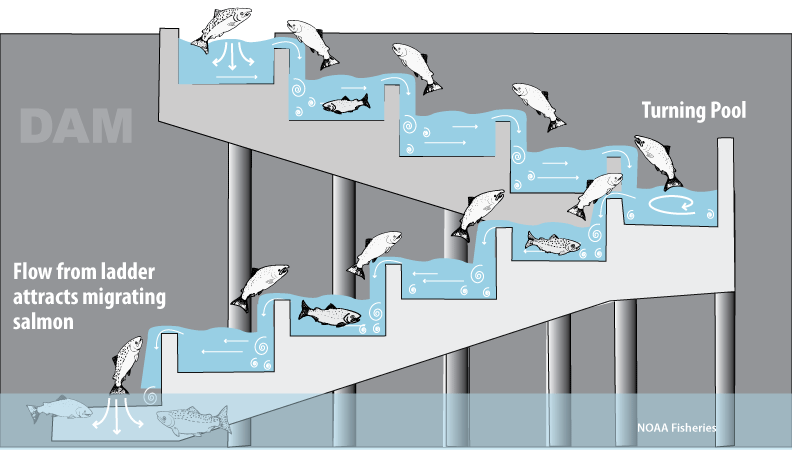
Cement “steps” or series of pools that migratory fish like salmon can use to continue migration upstream, around or over dams
Enables continued breeding for salmon, food source for predators like large birds, bears, and fishing revenue for humans
“Salmon cannon” is a similar alternative that enables salmon to be captured or directed into a tube that carries them over the dam
Benefits of Hydroelectric Dams
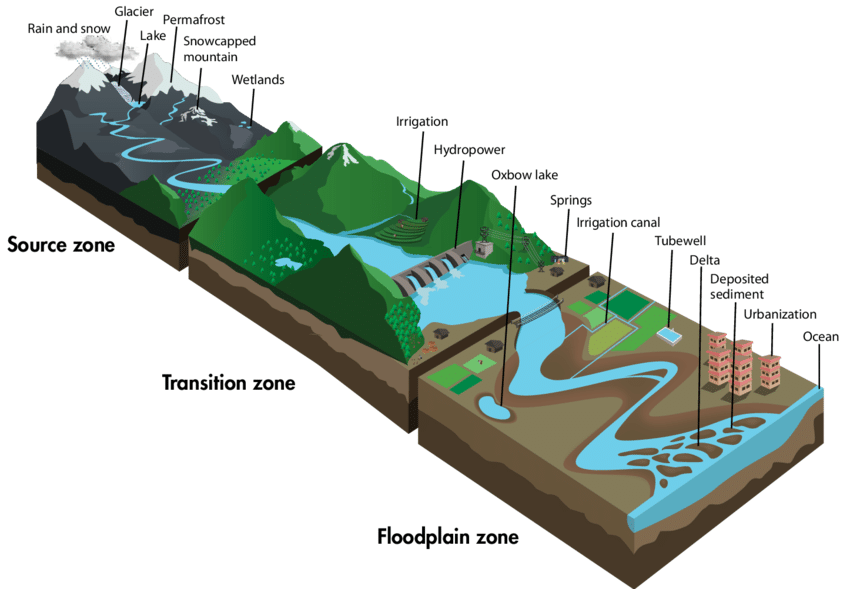
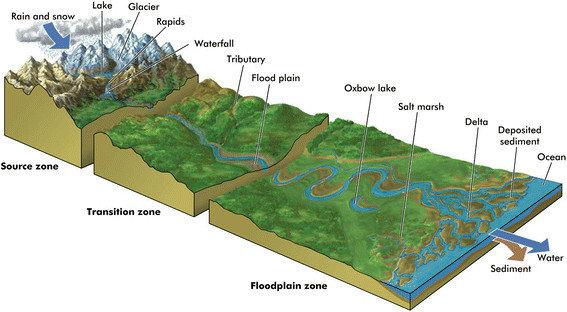
No GHG emissions when producing electricity (initial construction does require cement
Reservoir & dam can be tourist attractions
Jobs are created to maintain the dam
Reliable electricity source generated for surrounding area
No air pollutants released during electricity generation (no PM/SOx/NOx)
Allows for control of downstream seasonal flooding
In US, only 3% of dams are for hydroelectricity; 37% are for recreation/scenic purposes; 2nd most common purpose is flood control (allowing humans to build closer to rivers in floodplains that would normally be flooded seasonally)
This flood prevention is good for humans, but deprives river flood plains of nutrient-rich sediment that supports plant growth & nearby wetland habitats
6.10 Geothermal Energy
Geothermal Basics
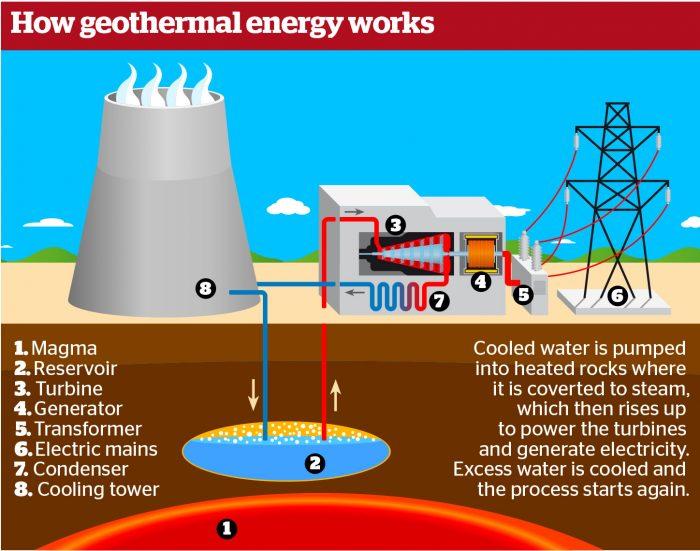
Natural radioactive decay of elements deep in earth’s core gives off heat, driving magma convection currents which carry heat to upper portion of mantle, close to earth’s surface
Water can be piped down into the ground and heated by this heat from the mantle
Hot water can be converted into steam → turbine → elect. or be used to heat homes directly
Geothermal for electricity: naturally heated water reservoirs underground are drilled into & piped up to the surface (or water can be piped down into naturally heated rock layers
The heat from magma turns the water into steam, which is forced through pipes to spin a turbine
Water is cooled in cooling tower & returned to the ground to start the process over
Renewable since heat from earth’s core won’t run out; but only if groundwater is returned after use
Ground Source Heat Pump

Often referred to as “geothermal” but technically the heat does not come from geologic activity (comes from the ground storing heat from the sun)
More accurate name is “ground source heat pump”
10 feet down, the ground stays a consistent 50-60o due to holding heat from sun (not warmed by geothermal energy from magma - so not technically geothermal energy)
Heat absorbing fluid is pumped through a pipe into the ground where it either takes on heat from the ground, or gives off heat to the ground
In summer, heat from home transfers to liquid & liquid transfers heat to the ground, cooling house
In winter, liquid takes heat from ground & transfers it to the house, warming house
Geothermal Heating
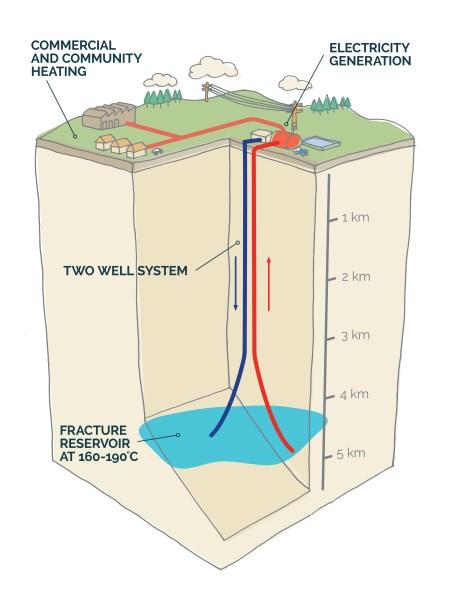
True geothermal heating involves piping water deep into ground to be heated by magma & then transfering heat from water to the building
Different than ground source heat pump
Well must go thousands of meters (kms) down into the ground to reach heated water reservoir
Heated water is piped up to surface & sent to homes or businesses to heat them
Geothermal Pros and Cons
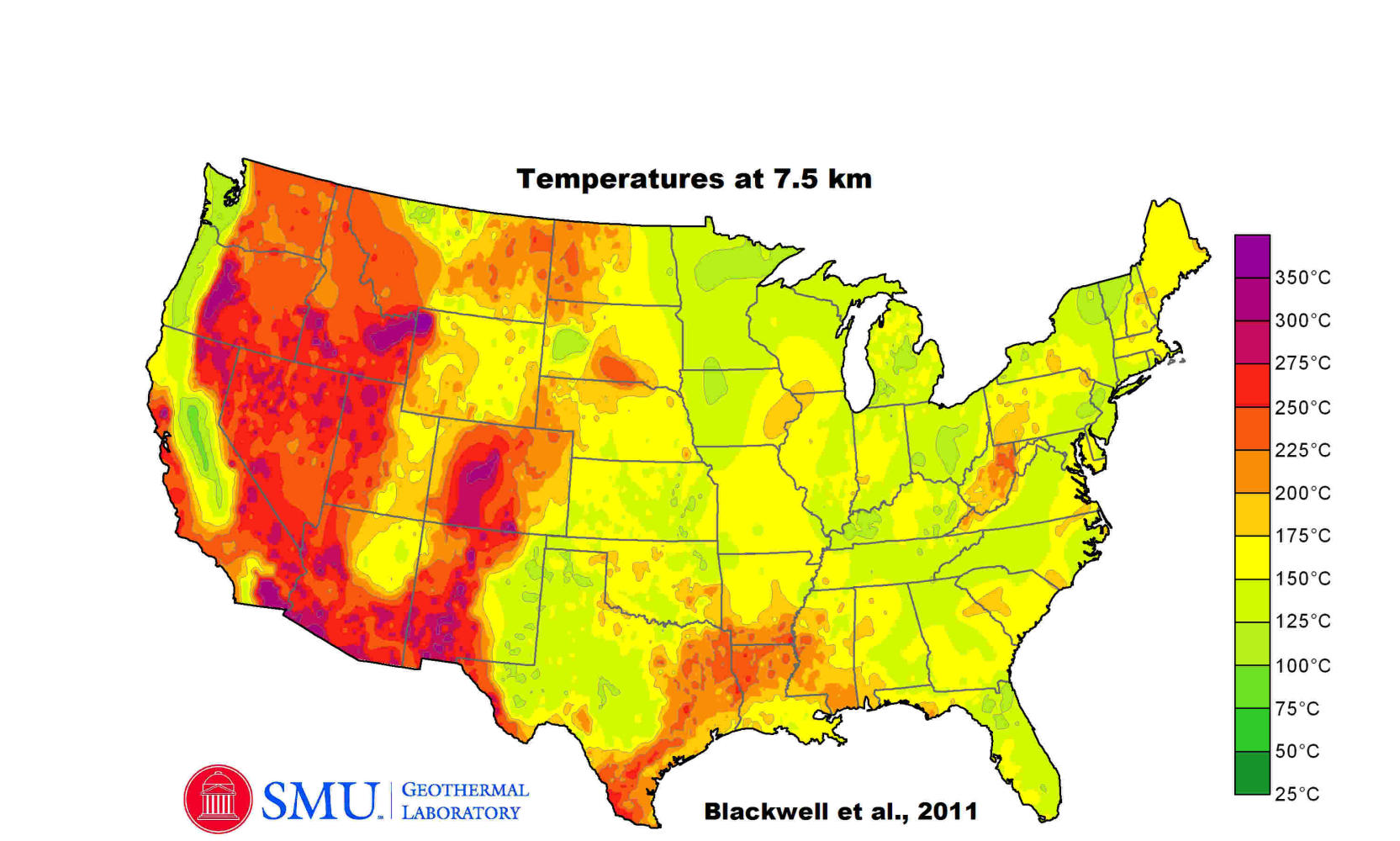
Pros
Potentially renewable, only if water is piped back into the ground for reuse
Much less CO2 emission than FF electricity
No release of (PM/SOx/NOx/CO) as is case with FFs
Cons
Not everywhere on earth has access to geothermal energy reaching close enough to surface to access it
Hydrogen sulfide can be released, which is toxic and can be lethal to humans & animals
Cost of drilling that deep in the earth can be very high initially
Sometimes so high that it’s not even worth it
6.11 Hydrogen Fuel Cell
Hydrogen Fuel Cell Basics
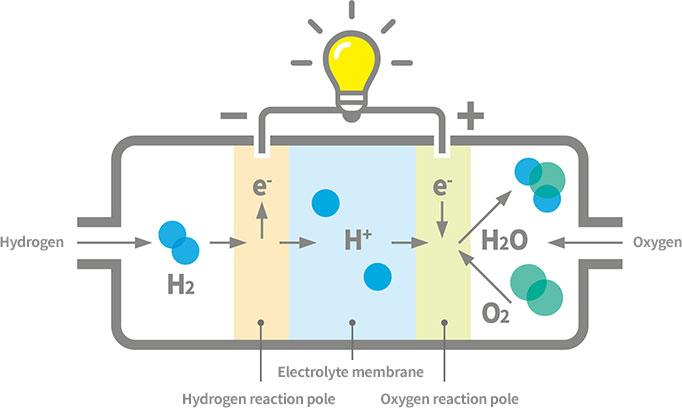
Use hydrogen as a renewable, alternative fuel source to fossil fuels
H2 gas and O2 are the inputs used to generate electricity; H2O is given off as a waste product
H2 gas enters fuel cell where it’s split into protons (H+) and electrons (e-) by an electrolyte membrane that only lets protons pass through
Electrons take an alternative route (circuit) around the membrane, which generates an electrical current
O2 molecules enter fuel cell break apart into individual O atoms and combine with two hydrogens (H+) to form H2O as a by product (only emissions from F fuel cells)
Most common application is in vehicles
Replaces gasoline (non-renewable, GHG releasing & air polluting) with H fuel (no air pollutants released & only H2O vapor)
Creating H2 Gas


Key challenge to H fuel cells is obtaining pure H gas (b/c it doesn’t exist by itself as a gas naturally)
Separating H2 gas from other molecules like H2O or CH4 is very energy intensive
Two main processes are steam reforming (95% of all H production) and electrolysis (less common, but more sustainable)
Steam Reforming: burning natural gas (CH4) & using steam to separate the H gas from the methane (CH4)
Emits CO2 & requires NG (FF) input
Electrolysis: electrical current is applied to water, breaking it into O2 and H2
No CO2 emission, but does require electricity
Hydrogen As an Energy Carrier (Pros)

Because H2 gas can be stored in pressurized tanks, it can be transported for use creating electricity later, in a different location
Unlike solar, hydro, and wind where the electricity must be used as soon as it’s generated & relatively closely to the location of generation
Can also be used as a fuel for vehicles (replacing gasoline) or to create ammonia for fertilizer, or in the chemical industry
As a gasoline replacement, it emits no air pollutants (NOx/PM/CO) and only H2O (tech. a GHG) no CO2
Manufacture of many different industrial chemicals requires H2 gas
Can be stored as liquid or gas, making it easy to transport
H fuel cells are ~80% efficient in converting chemical energy in H2 & O2 into electricity (Coal PP = 35% efficient)
Drawbacks of H Fuel Cells
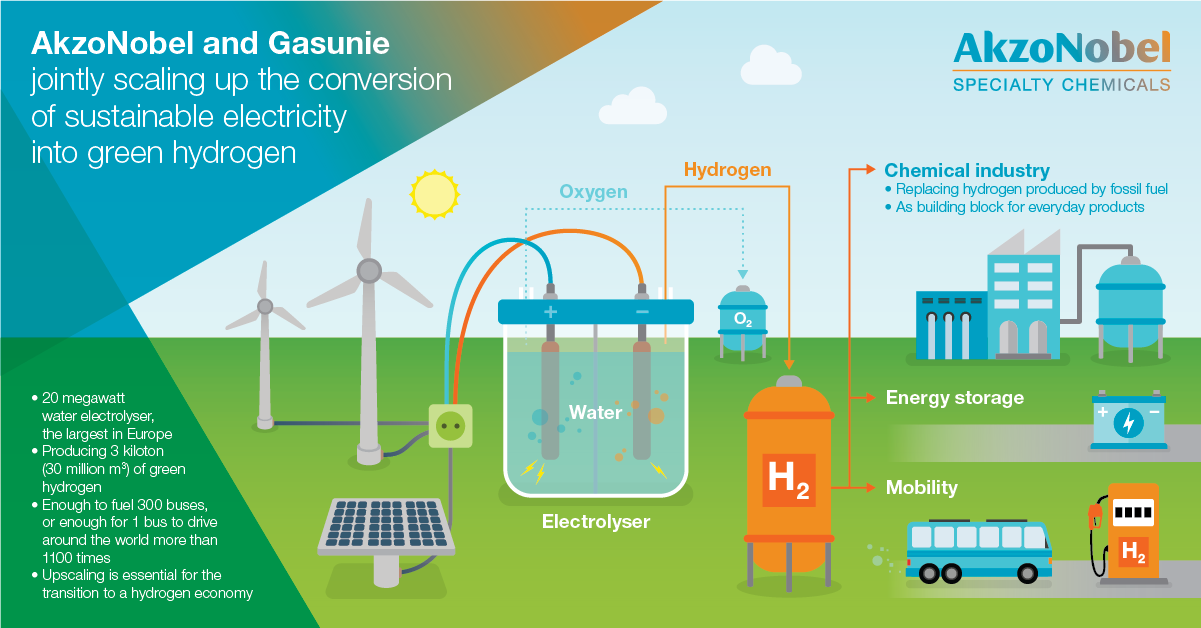
⛰Since 95% of H2 production requires methane (CH4), H fuel cells are based on a non-renewable & CO2 releasing energy source
If electrolysis is used to produce H2, it’s only as sustainable as the electricity source
Widespread H fuel cell use would require building widespread H distribution network (similar to current system for gasoline)
H fuel stored in gas form in vehicles would require much larger tanks than current gasoline tanks
6.12 Wind Energy
Wind Turbine Electricity Generation
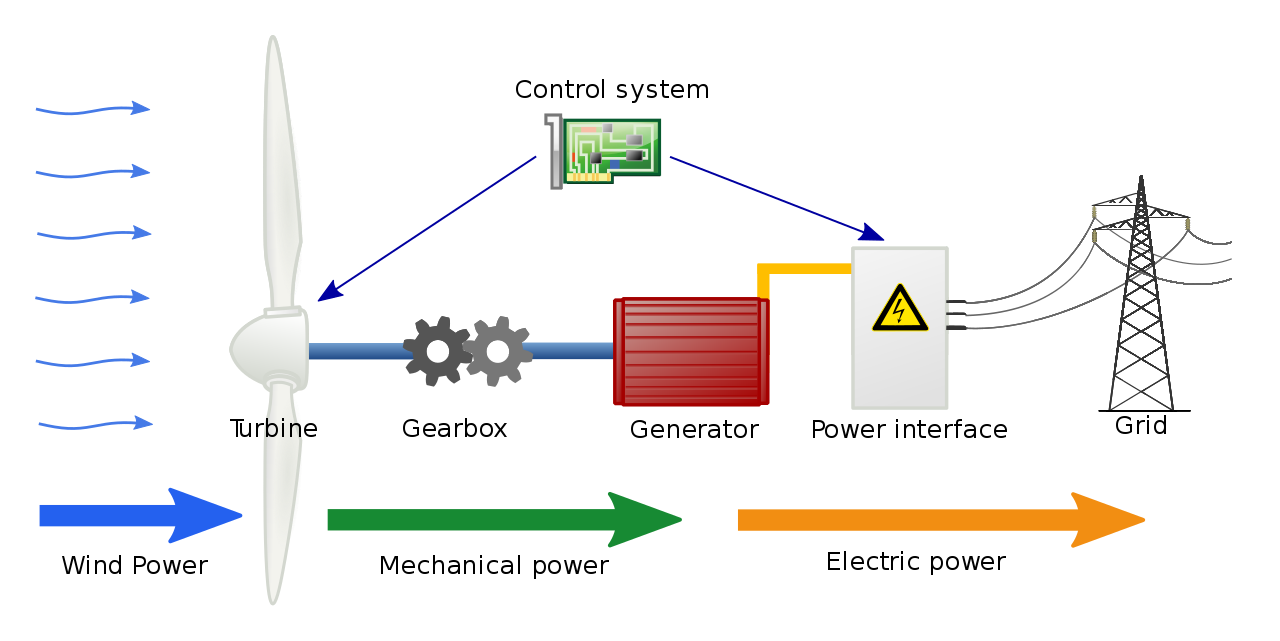
Kinetic energy of moving air (wind) spins a turbine; generator converts mechanical energy of turbine into electricity
Blades of turbine are connected to gearbox by a shaft that rotates; rotating gears create mechanical energy that the generator transforms into electricity
Avg. turbine can power 460 homes
Avg. wind turbine has 15-30% capacity factor (% of total possible energy it could generate)
Only produces electricity in 8-55 mph winds
Motorized drive within shaft can turn the turbine to face wind
Wind Turbine Location
Clustered in groups (wind projects or farms) in flat, open areas (usually rural)
Locating them together makes service, repair, and building transmission lines to them easier
Can share land with agricultural use
Offshore wind = wind farms in oceans or lakes
Capitalizes on faster wind speeds
Does require transmission lines built across long distances to reach land though
Wind Energy Benefits and Drawbacks
Benefits:
Non-depletable (isn’t decreased by its use) - even better than renewable!
No GHG emissions or air pollutants released when generating electricity
No CO2 (climate change) or NOx/SOx/PM as with burning FFs
Can share land uses (don’t destroy habitat or cause soil/water contamination as FFs do)
Drawbacks:
Intermittency (isn’t always available) can’t replace base-load power (sources that are always available like FFs, nuclear or Geothermal)
Can’t replace base-load power (sources that are always available like FFs, nuclear or Geothermal)
Can kill birds and bats (especially larger, migratory birds)
Can be considered an eyesore or source of noise pollution by some
6.13 Energy Conservation
Small Scale vs. Large Scale Energy Conservation
Small Scale:
Lowering thermostat to use less heat or use AC less often
Conserving water with native plants instead of grass, low flow shower heads, efficient toilets, dishwashers, dryers
Energy efficient appliances, better insulation to keep more heat in home
Large Scale:
Improving fuel efficiency (fuel economy) standards
Ex: 20 mpg → 30 mpg
Subsidizing (tax credits for) electric vehicles, charging stations, and hybrids
Increased public transport (buses & light rails), green building design
Sustainable Home Design

Ways to either block out or take advantages of sun’s natural heat, or keep in heating/cooling to decrease energy required
Deciduous shade trees for landscaping (leaves block sun in summer, but allow it in during winter)
Using passive solar design concepts to trap sun’s heat & decrease energy from heating system (heat absorbing walls, triple or double paned windows)
Well-insulated walls/attic to trap heat in winter & cool air from AC system in summer
This decreases electricity used by AC unit & energy used by heating system
Water Conservation
Native plants require less watering than traditional lawns (also increase biodiversity of pollinators & require less fertilizer)
Low-flow showers, toilets, and dishwashers do the same job with less total water (less energy to purify & pump to homes)
Rain barrels allow rain water to be used for watering plants or washing cars
Energy Conservation - Transportation
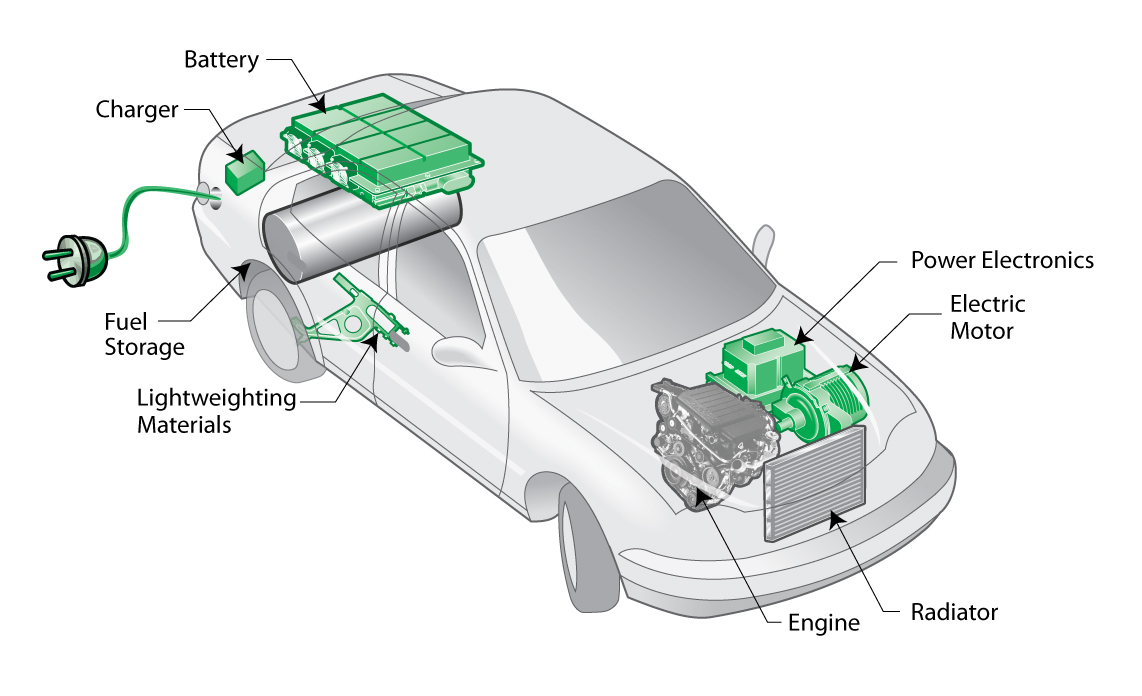

~28% of total US energy use comes from transport of goods & people (2019)
Improving fuel economy of US fleet of vehicles conserves energy as less gasoline/diesel is needed to travel same distance
CAFE (Corporate Average Fuel Economy) standards are regulations set in US to require auto manufacturers to make cars that meet certain MPG standards, or pay penalties
Hybrids (Prius) have both a gasoline & electric engine, enabling them to have higher MPG ratings
Breaking system charges the electric battery, which powers electric motor
Electric vehicles (EVs or BEVs) like the Tesla or LEAF use no gasoline, but still require electricity (only as sustainable as elect. source)
Public transit & carpooling are even better energy-saving transport options
Sustainable Building Design
Decreasing the amount of energy required to build larger buildings & heat/cool them
Green roof or walls can decrease runoff, and absorb sun’s heat, decreasing energy needed for cooling building & surrounding area (lessens heat island effect)
Sun lights on roof, or windows on sides can decrease electricity used for lighting
Recycled materials can reduce energy required to produce new ones (glass, wood, even fly ash from coal can be used in foundation)
Managing Peak Demand and Smart Grid Tech
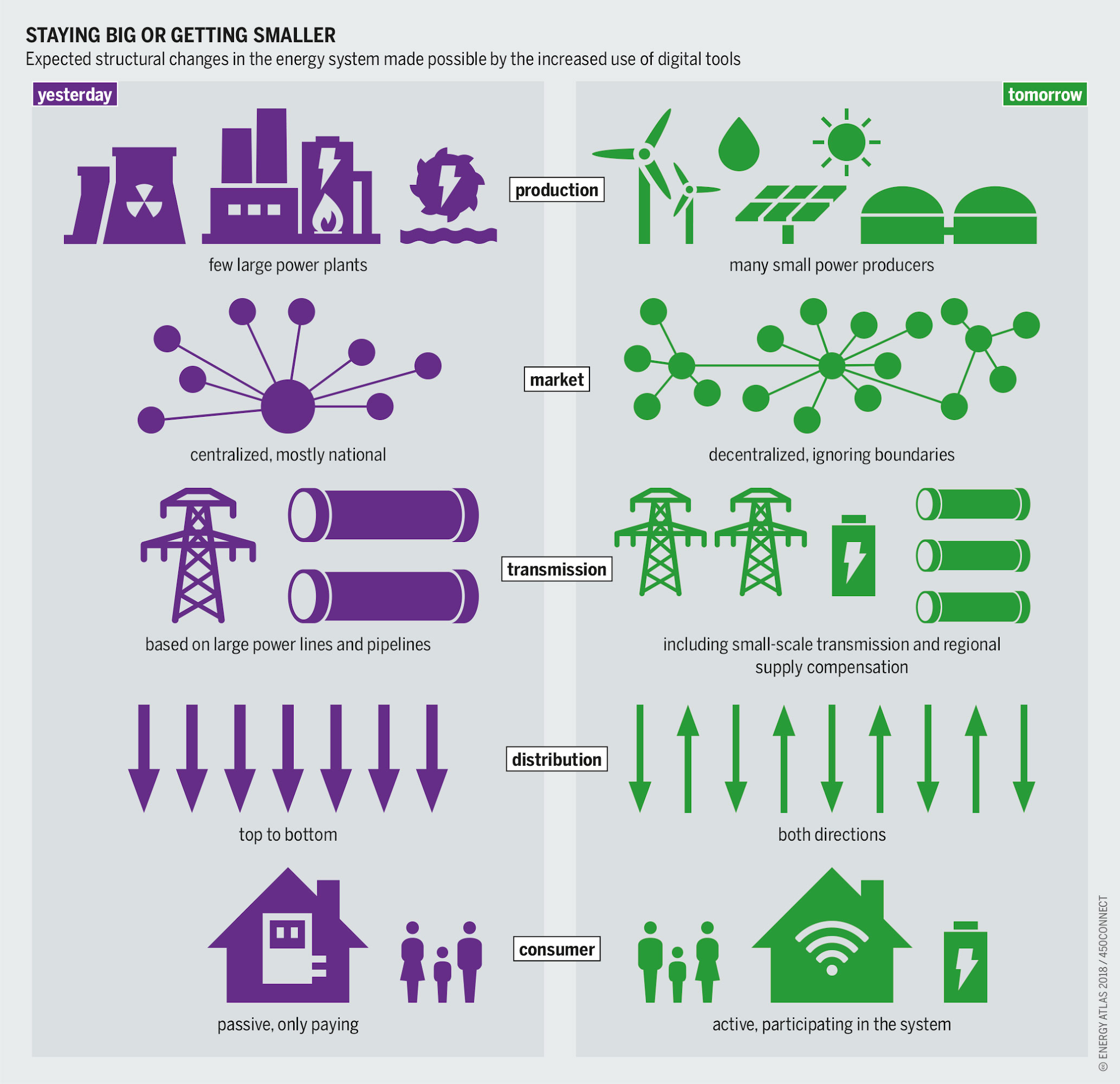
Peak demand is the time of day or year (often early night time hours or very hot weather events) that electricity demand is highest
If demand exceeds supply, rolling blackouts occur
To manage peak demand, some utilities use a variable price model for electricity
Users pay a higher rate during peak demand hours or events, to discourage use
Users pay a lower rate/kWh when using a lower amount of energy (incentivizes lower overall use)
“Smart Grid” is just the idea of managing demand & energy sources in a more varied way
Ex: using smart meters for variable price models, allowing rooftop solar to direct electricity back to grid, integrating more total energy sources (especially renewable)